Feasibility for Virtual Surgery in Remote Areas of Queensland
VerifiedAdded on 2023/06/05
|27
|6934
|487
AI Summary
This feasibility study explores the implementation of virtual surgery in remote areas of Queensland, highlighting the benefits and challenges of the technology. It includes a literature review, case studies, and strategic plan for feasibility.
Contribute Materials
Your contribution can guide someone’s learning journey. Share your
documents today.
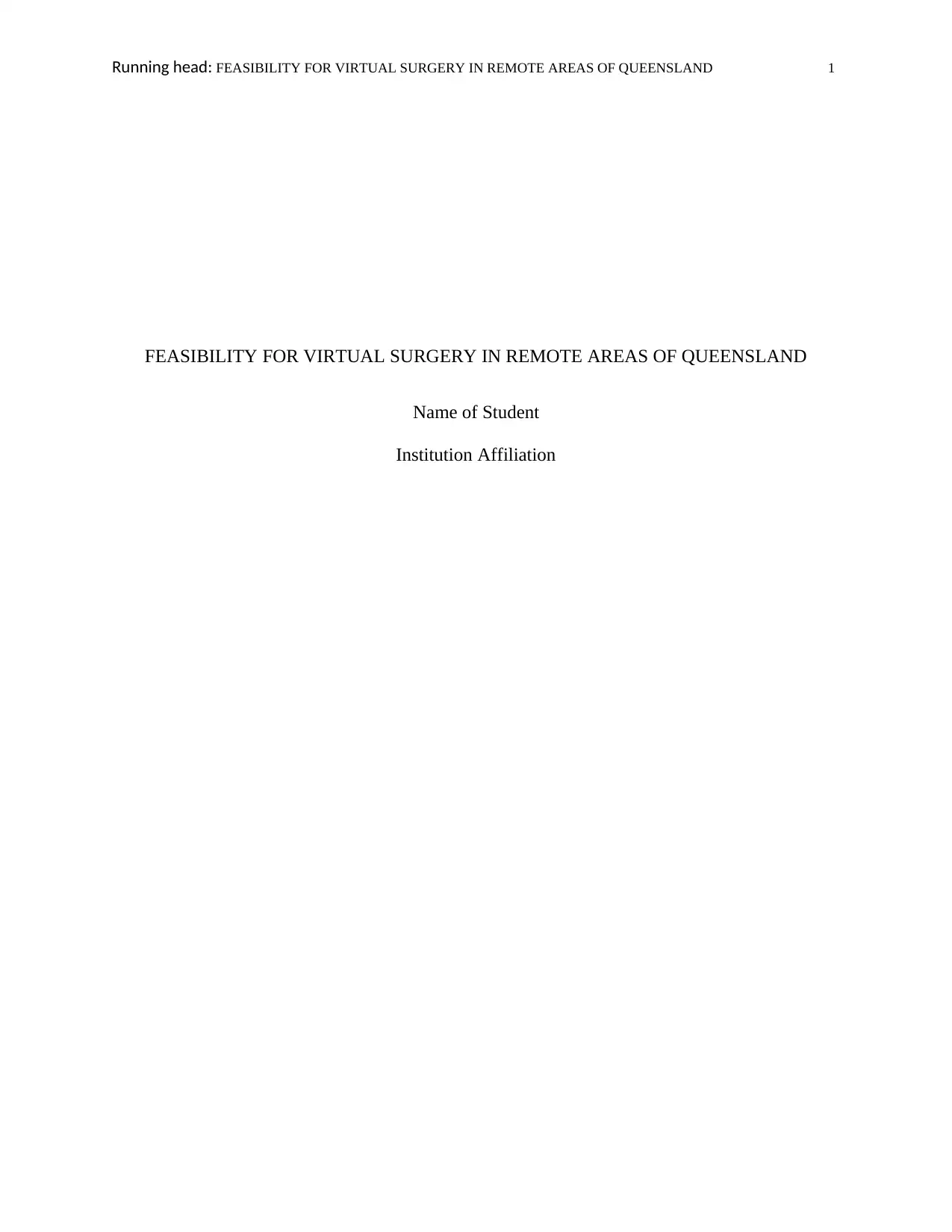
Running head: FEASIBILITY FOR VIRTUAL SURGERY IN REMOTE AREAS OF QUEENSLAND 1
FEASIBILITY FOR VIRTUAL SURGERY IN REMOTE AREAS OF QUEENSLAND
Name of Student
Institution Affiliation
FEASIBILITY FOR VIRTUAL SURGERY IN REMOTE AREAS OF QUEENSLAND
Name of Student
Institution Affiliation
Secure Best Marks with AI Grader
Need help grading? Try our AI Grader for instant feedback on your assignments.
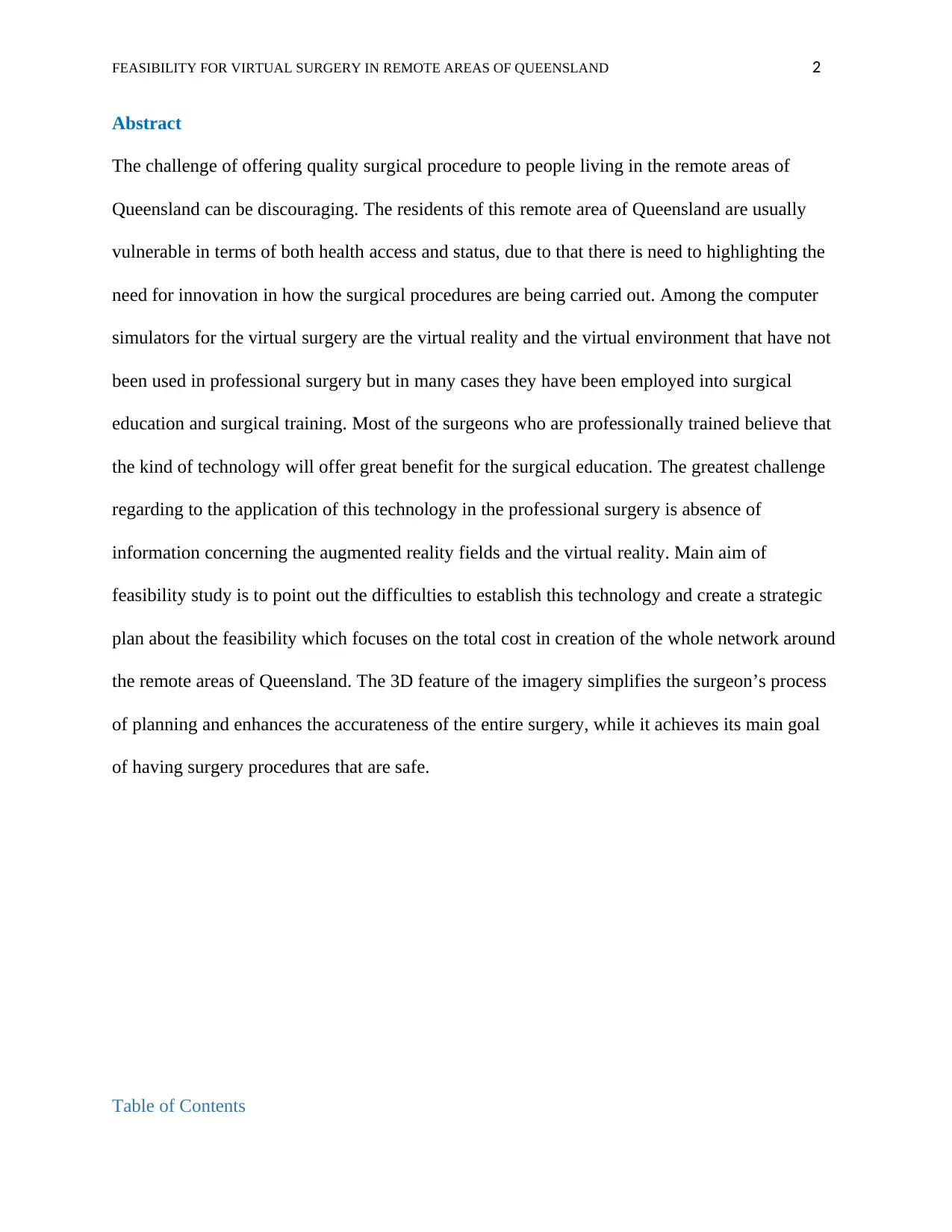
FEASIBILITY FOR VIRTUAL SURGERY IN REMOTE AREAS OF QUEENSLAND 2
Abstract
The challenge of offering quality surgical procedure to people living in the remote areas of
Queensland can be discouraging. The residents of this remote area of Queensland are usually
vulnerable in terms of both health access and status, due to that there is need to highlighting the
need for innovation in how the surgical procedures are being carried out. Among the computer
simulators for the virtual surgery are the virtual reality and the virtual environment that have not
been used in professional surgery but in many cases they have been employed into surgical
education and surgical training. Most of the surgeons who are professionally trained believe that
the kind of technology will offer great benefit for the surgical education. The greatest challenge
regarding to the application of this technology in the professional surgery is absence of
information concerning the augmented reality fields and the virtual reality. Main aim of
feasibility study is to point out the difficulties to establish this technology and create a strategic
plan about the feasibility which focuses on the total cost in creation of the whole network around
the remote areas of Queensland. The 3D feature of the imagery simplifies the surgeon’s process
of planning and enhances the accurateness of the entire surgery, while it achieves its main goal
of having surgery procedures that are safe.
Table of Contents
Abstract
The challenge of offering quality surgical procedure to people living in the remote areas of
Queensland can be discouraging. The residents of this remote area of Queensland are usually
vulnerable in terms of both health access and status, due to that there is need to highlighting the
need for innovation in how the surgical procedures are being carried out. Among the computer
simulators for the virtual surgery are the virtual reality and the virtual environment that have not
been used in professional surgery but in many cases they have been employed into surgical
education and surgical training. Most of the surgeons who are professionally trained believe that
the kind of technology will offer great benefit for the surgical education. The greatest challenge
regarding to the application of this technology in the professional surgery is absence of
information concerning the augmented reality fields and the virtual reality. Main aim of
feasibility study is to point out the difficulties to establish this technology and create a strategic
plan about the feasibility which focuses on the total cost in creation of the whole network around
the remote areas of Queensland. The 3D feature of the imagery simplifies the surgeon’s process
of planning and enhances the accurateness of the entire surgery, while it achieves its main goal
of having surgery procedures that are safe.
Table of Contents
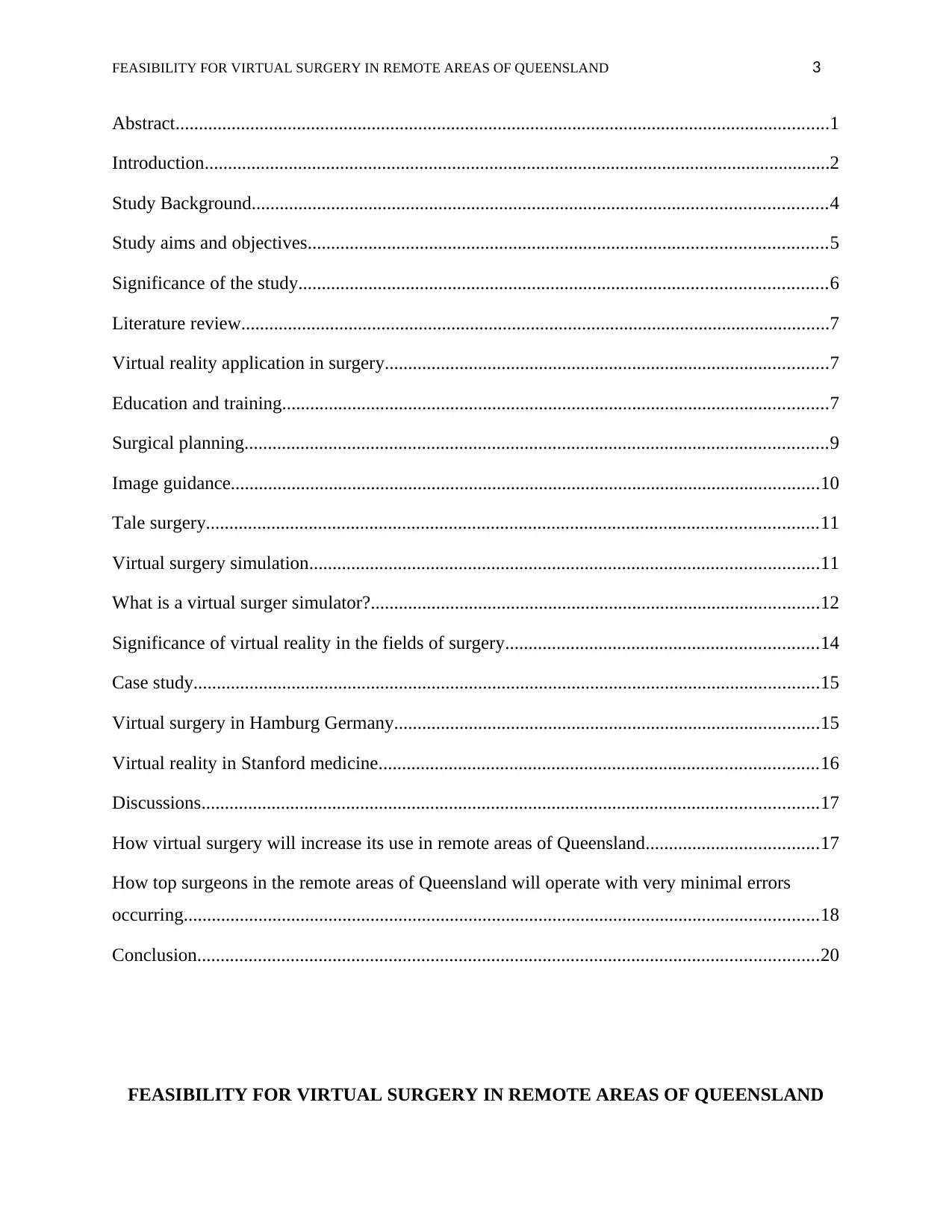
FEASIBILITY FOR VIRTUAL SURGERY IN REMOTE AREAS OF QUEENSLAND 3
Abstract............................................................................................................................................1
Introduction......................................................................................................................................2
Study Background...........................................................................................................................4
Study aims and objectives...............................................................................................................5
Significance of the study.................................................................................................................6
Literature review..............................................................................................................................7
Virtual reality application in surgery...............................................................................................7
Education and training.....................................................................................................................7
Surgical planning.............................................................................................................................9
Image guidance..............................................................................................................................10
Tale surgery...................................................................................................................................11
Virtual surgery simulation.............................................................................................................11
What is a virtual surger simulator?................................................................................................12
Significance of virtual reality in the fields of surgery...................................................................14
Case study......................................................................................................................................15
Virtual surgery in Hamburg Germany...........................................................................................15
Virtual reality in Stanford medicine..............................................................................................16
Discussions....................................................................................................................................17
How virtual surgery will increase its use in remote areas of Queensland.....................................17
How top surgeons in the remote areas of Queensland will operate with very minimal errors
occurring........................................................................................................................................18
Conclusion.....................................................................................................................................20
FEASIBILITY FOR VIRTUAL SURGERY IN REMOTE AREAS OF QUEENSLAND
Abstract............................................................................................................................................1
Introduction......................................................................................................................................2
Study Background...........................................................................................................................4
Study aims and objectives...............................................................................................................5
Significance of the study.................................................................................................................6
Literature review..............................................................................................................................7
Virtual reality application in surgery...............................................................................................7
Education and training.....................................................................................................................7
Surgical planning.............................................................................................................................9
Image guidance..............................................................................................................................10
Tale surgery...................................................................................................................................11
Virtual surgery simulation.............................................................................................................11
What is a virtual surger simulator?................................................................................................12
Significance of virtual reality in the fields of surgery...................................................................14
Case study......................................................................................................................................15
Virtual surgery in Hamburg Germany...........................................................................................15
Virtual reality in Stanford medicine..............................................................................................16
Discussions....................................................................................................................................17
How virtual surgery will increase its use in remote areas of Queensland.....................................17
How top surgeons in the remote areas of Queensland will operate with very minimal errors
occurring........................................................................................................................................18
Conclusion.....................................................................................................................................20
FEASIBILITY FOR VIRTUAL SURGERY IN REMOTE AREAS OF QUEENSLAND
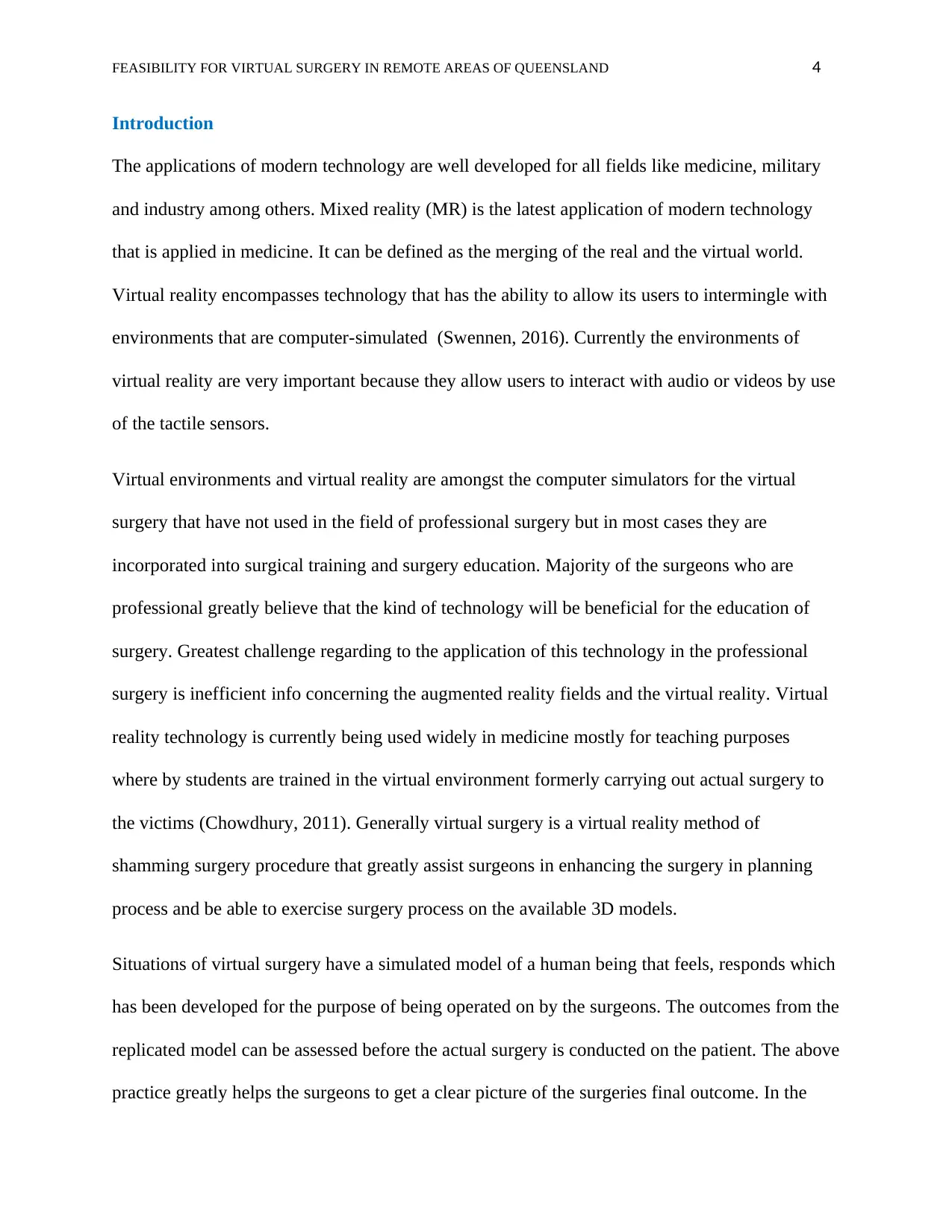
FEASIBILITY FOR VIRTUAL SURGERY IN REMOTE AREAS OF QUEENSLAND 4
Introduction
The applications of modern technology are well developed for all fields like medicine, military
and industry among others. Mixed reality (MR) is the latest application of modern technology
that is applied in medicine. It can be defined as the merging of the real and the virtual world.
Virtual reality encompasses technology that has the ability to allow its users to intermingle with
environments that are computer-simulated (Swennen, 2016). Currently the environments of
virtual reality are very important because they allow users to interact with audio or videos by use
of the tactile sensors.
Virtual environments and virtual reality are amongst the computer simulators for the virtual
surgery that have not used in the field of professional surgery but in most cases they are
incorporated into surgical training and surgery education. Majority of the surgeons who are
professional greatly believe that the kind of technology will be beneficial for the education of
surgery. Greatest challenge regarding to the application of this technology in the professional
surgery is inefficient info concerning the augmented reality fields and the virtual reality. Virtual
reality technology is currently being used widely in medicine mostly for teaching purposes
where by students are trained in the virtual environment formerly carrying out actual surgery to
the victims (Chowdhury, 2011). Generally virtual surgery is a virtual reality method of
shamming surgery procedure that greatly assist surgeons in enhancing the surgery in planning
process and be able to exercise surgery process on the available 3D models.
Situations of virtual surgery have a simulated model of a human being that feels, responds which
has been developed for the purpose of being operated on by the surgeons. The outcomes from the
replicated model can be assessed before the actual surgery is conducted on the patient. The above
practice greatly helps the surgeons to get a clear picture of the surgeries final outcome. In the
Introduction
The applications of modern technology are well developed for all fields like medicine, military
and industry among others. Mixed reality (MR) is the latest application of modern technology
that is applied in medicine. It can be defined as the merging of the real and the virtual world.
Virtual reality encompasses technology that has the ability to allow its users to intermingle with
environments that are computer-simulated (Swennen, 2016). Currently the environments of
virtual reality are very important because they allow users to interact with audio or videos by use
of the tactile sensors.
Virtual environments and virtual reality are amongst the computer simulators for the virtual
surgery that have not used in the field of professional surgery but in most cases they are
incorporated into surgical training and surgery education. Majority of the surgeons who are
professional greatly believe that the kind of technology will be beneficial for the education of
surgery. Greatest challenge regarding to the application of this technology in the professional
surgery is inefficient info concerning the augmented reality fields and the virtual reality. Virtual
reality technology is currently being used widely in medicine mostly for teaching purposes
where by students are trained in the virtual environment formerly carrying out actual surgery to
the victims (Chowdhury, 2011). Generally virtual surgery is a virtual reality method of
shamming surgery procedure that greatly assist surgeons in enhancing the surgery in planning
process and be able to exercise surgery process on the available 3D models.
Situations of virtual surgery have a simulated model of a human being that feels, responds which
has been developed for the purpose of being operated on by the surgeons. The outcomes from the
replicated model can be assessed before the actual surgery is conducted on the patient. The above
practice greatly helps the surgeons to get a clear picture of the surgeries final outcome. In the
Secure Best Marks with AI Grader
Need help grading? Try our AI Grader for instant feedback on your assignments.
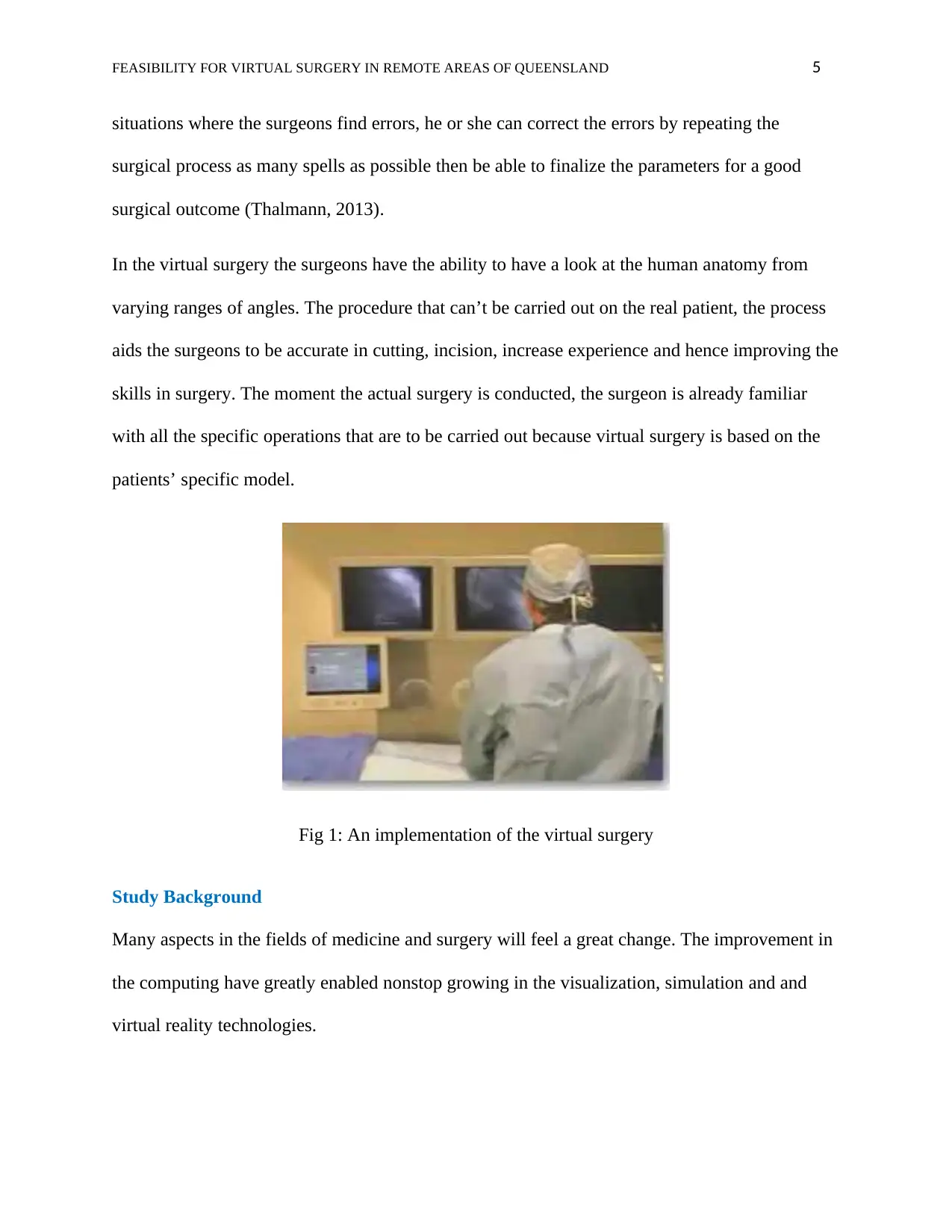
FEASIBILITY FOR VIRTUAL SURGERY IN REMOTE AREAS OF QUEENSLAND 5
situations where the surgeons find errors, he or she can correct the errors by repeating the
surgical process as many spells as possible then be able to finalize the parameters for a good
surgical outcome (Thalmann, 2013).
In the virtual surgery the surgeons have the ability to have a look at the human anatomy from
varying ranges of angles. The procedure that can’t be carried out on the real patient, the process
aids the surgeons to be accurate in cutting, incision, increase experience and hence improving the
skills in surgery. The moment the actual surgery is conducted, the surgeon is already familiar
with all the specific operations that are to be carried out because virtual surgery is based on the
patients’ specific model.
Fig 1: An implementation of the virtual surgery
Study Background
Many aspects in the fields of medicine and surgery will feel a great change. The improvement in
the computing have greatly enabled nonstop growing in the visualization, simulation and and
virtual reality technologies.
situations where the surgeons find errors, he or she can correct the errors by repeating the
surgical process as many spells as possible then be able to finalize the parameters for a good
surgical outcome (Thalmann, 2013).
In the virtual surgery the surgeons have the ability to have a look at the human anatomy from
varying ranges of angles. The procedure that can’t be carried out on the real patient, the process
aids the surgeons to be accurate in cutting, incision, increase experience and hence improving the
skills in surgery. The moment the actual surgery is conducted, the surgeon is already familiar
with all the specific operations that are to be carried out because virtual surgery is based on the
patients’ specific model.
Fig 1: An implementation of the virtual surgery
Study Background
Many aspects in the fields of medicine and surgery will feel a great change. The improvement in
the computing have greatly enabled nonstop growing in the visualization, simulation and and
virtual reality technologies.
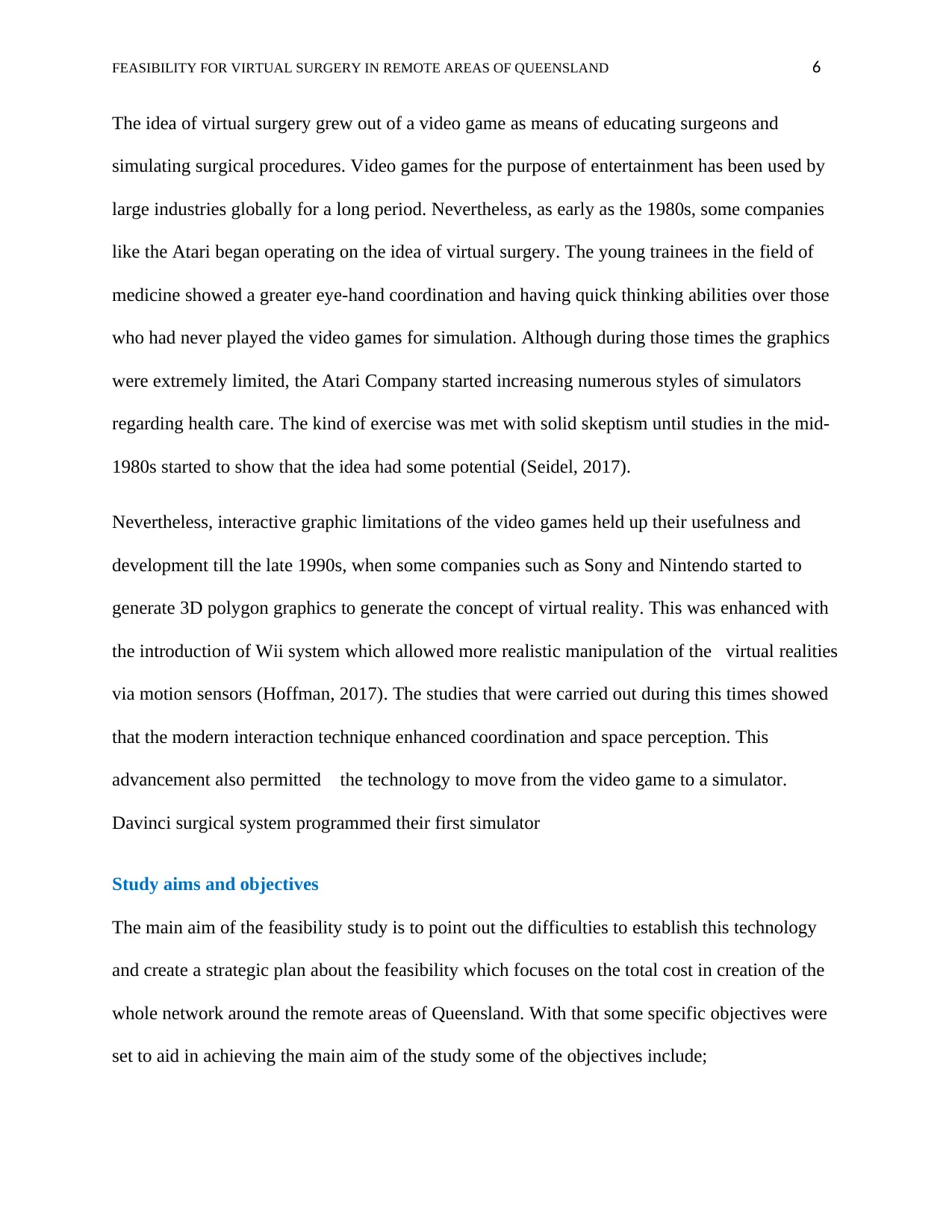
FEASIBILITY FOR VIRTUAL SURGERY IN REMOTE AREAS OF QUEENSLAND 6
The idea of virtual surgery grew out of a video game as means of educating surgeons and
simulating surgical procedures. Video games for the purpose of entertainment has been used by
large industries globally for a long period. Nevertheless, as early as the 1980s, some companies
like the Atari began operating on the idea of virtual surgery. The young trainees in the field of
medicine showed a greater eye-hand coordination and having quick thinking abilities over those
who had never played the video games for simulation. Although during those times the graphics
were extremely limited, the Atari Company started increasing numerous styles of simulators
regarding health care. The kind of exercise was met with solid skeptism until studies in the mid-
1980s started to show that the idea had some potential (Seidel, 2017).
Nevertheless, interactive graphic limitations of the video games held up their usefulness and
development till the late 1990s, when some companies such as Sony and Nintendo started to
generate 3D polygon graphics to generate the concept of virtual reality. This was enhanced with
the introduction of Wii system which allowed more realistic manipulation of the virtual realities
via motion sensors (Hoffman, 2017). The studies that were carried out during this times showed
that the modern interaction technique enhanced coordination and space perception. This
advancement also permitted the technology to move from the video game to a simulator.
Davinci surgical system programmed their first simulator
Study aims and objectives
The main aim of the feasibility study is to point out the difficulties to establish this technology
and create a strategic plan about the feasibility which focuses on the total cost in creation of the
whole network around the remote areas of Queensland. With that some specific objectives were
set to aid in achieving the main aim of the study some of the objectives include;
The idea of virtual surgery grew out of a video game as means of educating surgeons and
simulating surgical procedures. Video games for the purpose of entertainment has been used by
large industries globally for a long period. Nevertheless, as early as the 1980s, some companies
like the Atari began operating on the idea of virtual surgery. The young trainees in the field of
medicine showed a greater eye-hand coordination and having quick thinking abilities over those
who had never played the video games for simulation. Although during those times the graphics
were extremely limited, the Atari Company started increasing numerous styles of simulators
regarding health care. The kind of exercise was met with solid skeptism until studies in the mid-
1980s started to show that the idea had some potential (Seidel, 2017).
Nevertheless, interactive graphic limitations of the video games held up their usefulness and
development till the late 1990s, when some companies such as Sony and Nintendo started to
generate 3D polygon graphics to generate the concept of virtual reality. This was enhanced with
the introduction of Wii system which allowed more realistic manipulation of the virtual realities
via motion sensors (Hoffman, 2017). The studies that were carried out during this times showed
that the modern interaction technique enhanced coordination and space perception. This
advancement also permitted the technology to move from the video game to a simulator.
Davinci surgical system programmed their first simulator
Study aims and objectives
The main aim of the feasibility study is to point out the difficulties to establish this technology
and create a strategic plan about the feasibility which focuses on the total cost in creation of the
whole network around the remote areas of Queensland. With that some specific objectives were
set to aid in achieving the main aim of the study some of the objectives include;
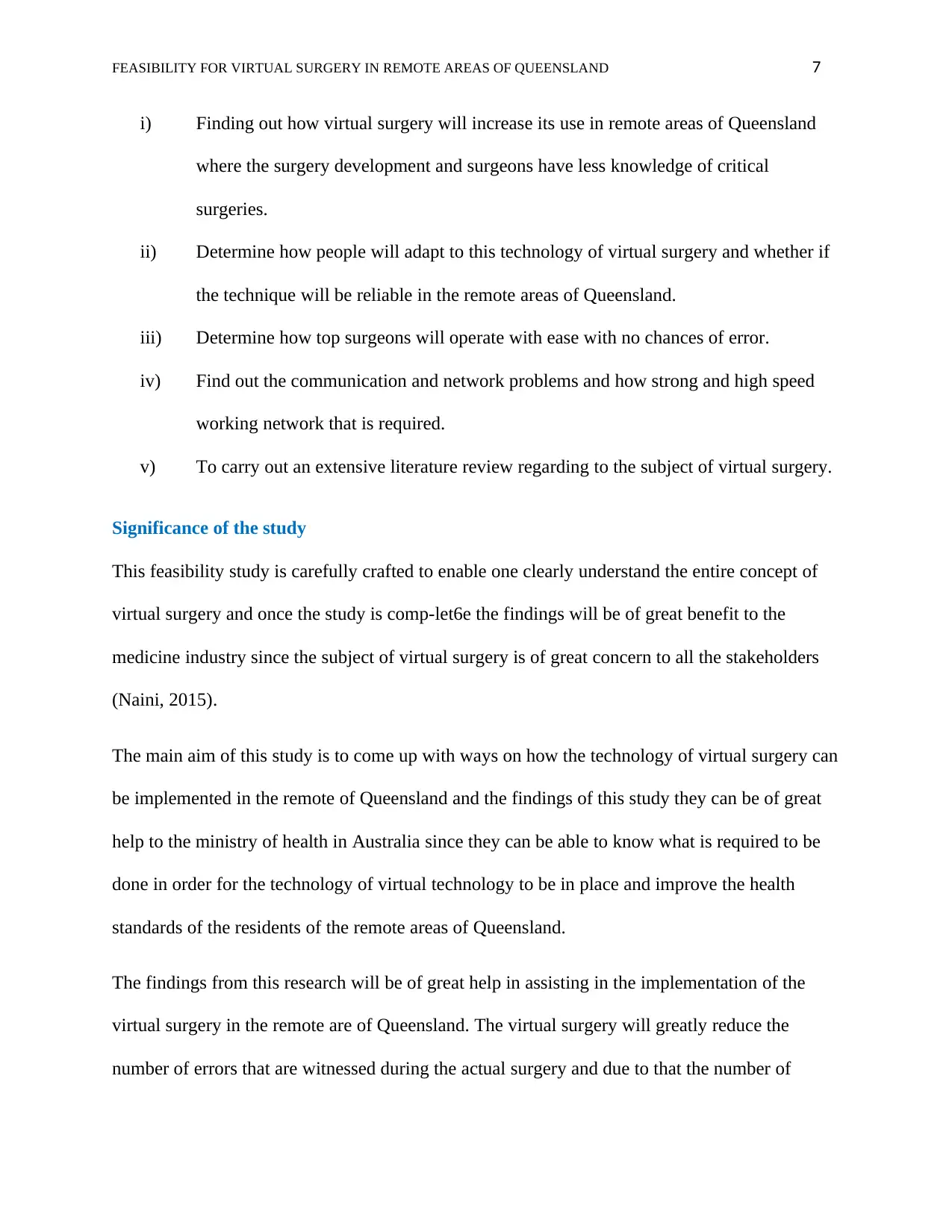
FEASIBILITY FOR VIRTUAL SURGERY IN REMOTE AREAS OF QUEENSLAND 7
i) Finding out how virtual surgery will increase its use in remote areas of Queensland
where the surgery development and surgeons have less knowledge of critical
surgeries.
ii) Determine how people will adapt to this technology of virtual surgery and whether if
the technique will be reliable in the remote areas of Queensland.
iii) Determine how top surgeons will operate with ease with no chances of error.
iv) Find out the communication and network problems and how strong and high speed
working network that is required.
v) To carry out an extensive literature review regarding to the subject of virtual surgery.
Significance of the study
This feasibility study is carefully crafted to enable one clearly understand the entire concept of
virtual surgery and once the study is comp-let6e the findings will be of great benefit to the
medicine industry since the subject of virtual surgery is of great concern to all the stakeholders
(Naini, 2015).
The main aim of this study is to come up with ways on how the technology of virtual surgery can
be implemented in the remote of Queensland and the findings of this study they can be of great
help to the ministry of health in Australia since they can be able to know what is required to be
done in order for the technology of virtual technology to be in place and improve the health
standards of the residents of the remote areas of Queensland.
The findings from this research will be of great help in assisting in the implementation of the
virtual surgery in the remote are of Queensland. The virtual surgery will greatly reduce the
number of errors that are witnessed during the actual surgery and due to that the number of
i) Finding out how virtual surgery will increase its use in remote areas of Queensland
where the surgery development and surgeons have less knowledge of critical
surgeries.
ii) Determine how people will adapt to this technology of virtual surgery and whether if
the technique will be reliable in the remote areas of Queensland.
iii) Determine how top surgeons will operate with ease with no chances of error.
iv) Find out the communication and network problems and how strong and high speed
working network that is required.
v) To carry out an extensive literature review regarding to the subject of virtual surgery.
Significance of the study
This feasibility study is carefully crafted to enable one clearly understand the entire concept of
virtual surgery and once the study is comp-let6e the findings will be of great benefit to the
medicine industry since the subject of virtual surgery is of great concern to all the stakeholders
(Naini, 2015).
The main aim of this study is to come up with ways on how the technology of virtual surgery can
be implemented in the remote of Queensland and the findings of this study they can be of great
help to the ministry of health in Australia since they can be able to know what is required to be
done in order for the technology of virtual technology to be in place and improve the health
standards of the residents of the remote areas of Queensland.
The findings from this research will be of great help in assisting in the implementation of the
virtual surgery in the remote are of Queensland. The virtual surgery will greatly reduce the
number of errors that are witnessed during the actual surgery and due to that the number of
Paraphrase This Document
Need a fresh take? Get an instant paraphrase of this document with our AI Paraphraser
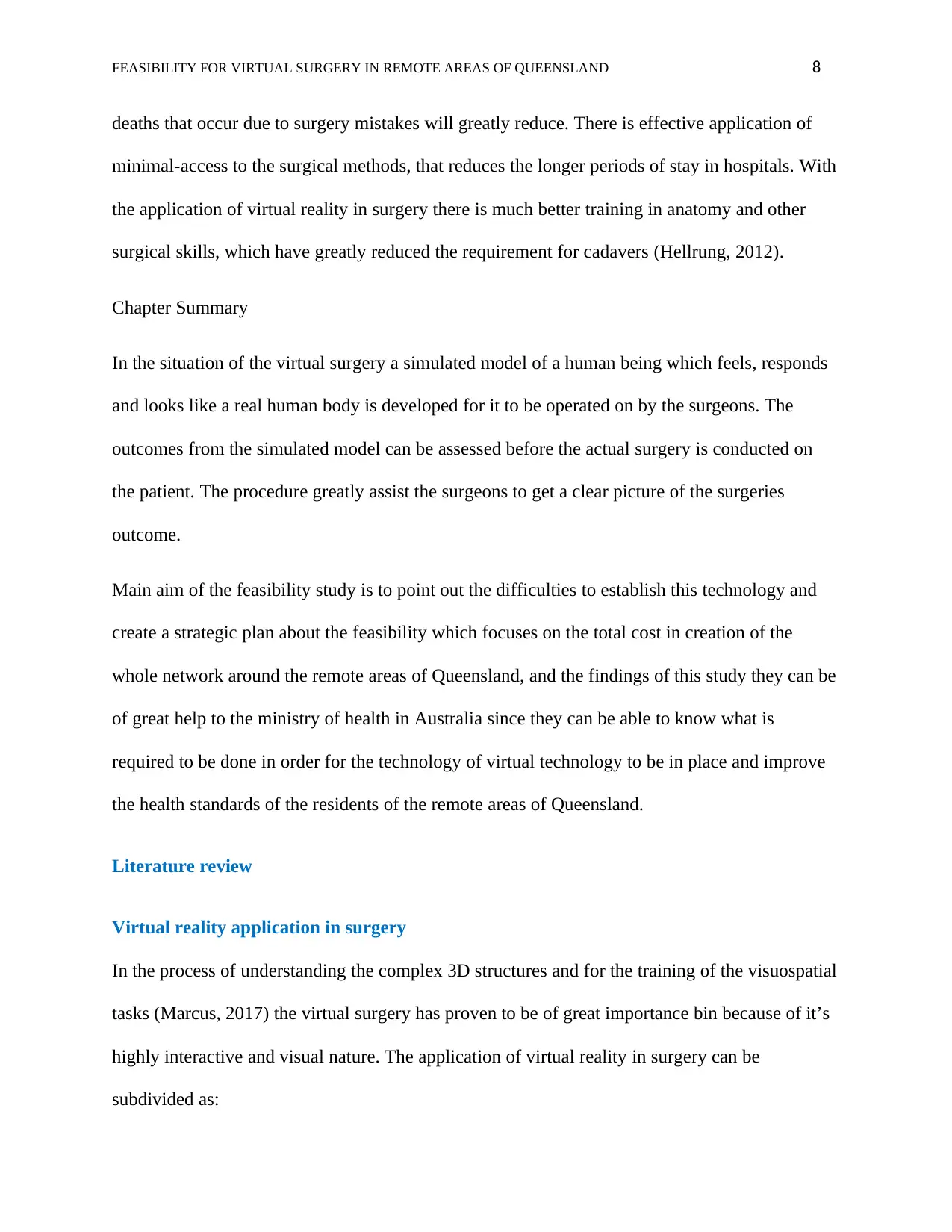
FEASIBILITY FOR VIRTUAL SURGERY IN REMOTE AREAS OF QUEENSLAND 8
deaths that occur due to surgery mistakes will greatly reduce. There is effective application of
minimal-access to the surgical methods, that reduces the longer periods of stay in hospitals. With
the application of virtual reality in surgery there is much better training in anatomy and other
surgical skills, which have greatly reduced the requirement for cadavers (Hellrung, 2012).
Chapter Summary
In the situation of the virtual surgery a simulated model of a human being which feels, responds
and looks like a real human body is developed for it to be operated on by the surgeons. The
outcomes from the simulated model can be assessed before the actual surgery is conducted on
the patient. The procedure greatly assist the surgeons to get a clear picture of the surgeries
outcome.
Main aim of the feasibility study is to point out the difficulties to establish this technology and
create a strategic plan about the feasibility which focuses on the total cost in creation of the
whole network around the remote areas of Queensland, and the findings of this study they can be
of great help to the ministry of health in Australia since they can be able to know what is
required to be done in order for the technology of virtual technology to be in place and improve
the health standards of the residents of the remote areas of Queensland.
Literature review
Virtual reality application in surgery
In the process of understanding the complex 3D structures and for the training of the visuospatial
tasks (Marcus, 2017) the virtual surgery has proven to be of great importance bin because of it’s
highly interactive and visual nature. The application of virtual reality in surgery can be
subdivided as:
deaths that occur due to surgery mistakes will greatly reduce. There is effective application of
minimal-access to the surgical methods, that reduces the longer periods of stay in hospitals. With
the application of virtual reality in surgery there is much better training in anatomy and other
surgical skills, which have greatly reduced the requirement for cadavers (Hellrung, 2012).
Chapter Summary
In the situation of the virtual surgery a simulated model of a human being which feels, responds
and looks like a real human body is developed for it to be operated on by the surgeons. The
outcomes from the simulated model can be assessed before the actual surgery is conducted on
the patient. The procedure greatly assist the surgeons to get a clear picture of the surgeries
outcome.
Main aim of the feasibility study is to point out the difficulties to establish this technology and
create a strategic plan about the feasibility which focuses on the total cost in creation of the
whole network around the remote areas of Queensland, and the findings of this study they can be
of great help to the ministry of health in Australia since they can be able to know what is
required to be done in order for the technology of virtual technology to be in place and improve
the health standards of the residents of the remote areas of Queensland.
Literature review
Virtual reality application in surgery
In the process of understanding the complex 3D structures and for the training of the visuospatial
tasks (Marcus, 2017) the virtual surgery has proven to be of great importance bin because of it’s
highly interactive and visual nature. The application of virtual reality in surgery can be
subdivided as:
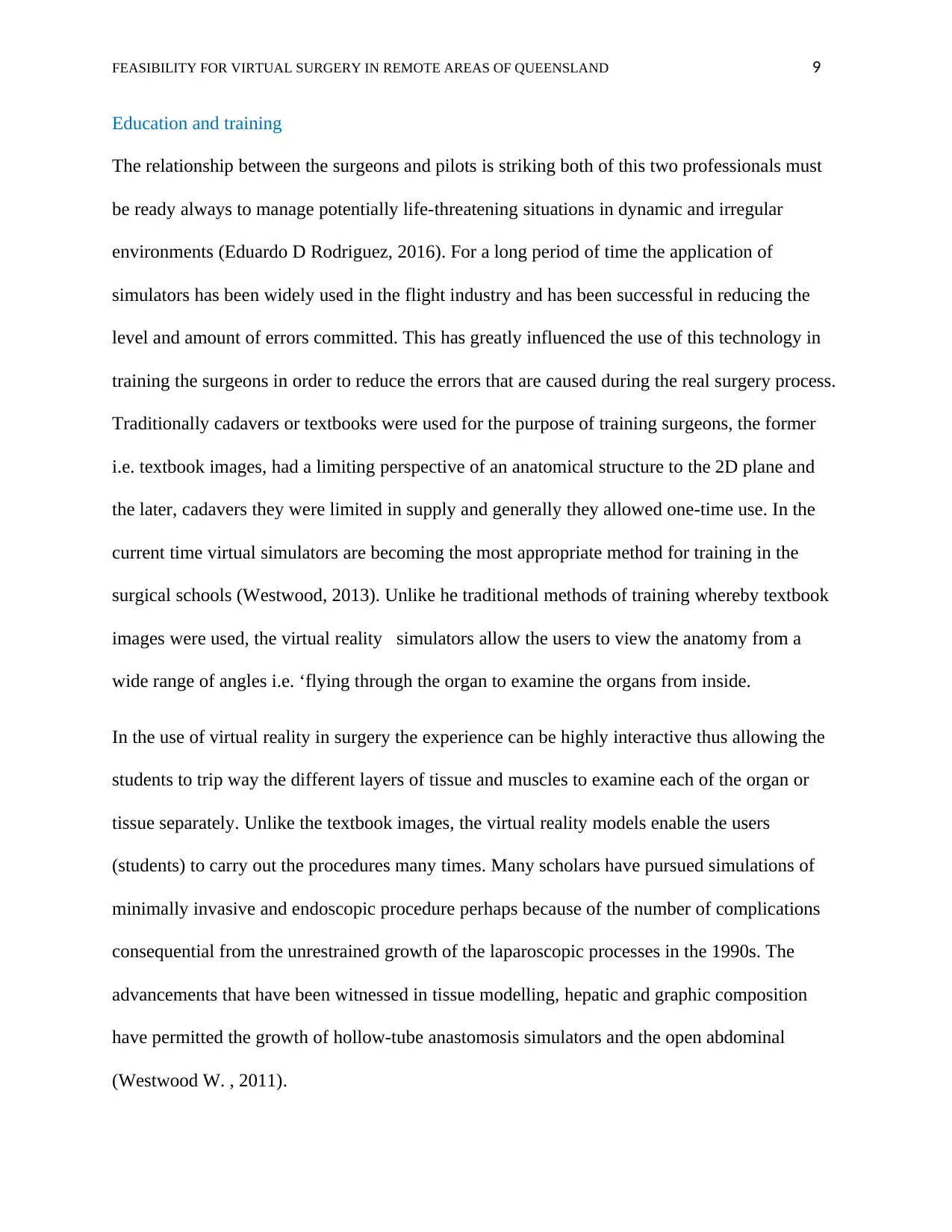
FEASIBILITY FOR VIRTUAL SURGERY IN REMOTE AREAS OF QUEENSLAND 9
Education and training
The relationship between the surgeons and pilots is striking both of this two professionals must
be ready always to manage potentially life-threatening situations in dynamic and irregular
environments (Eduardo D Rodriguez, 2016). For a long period of time the application of
simulators has been widely used in the flight industry and has been successful in reducing the
level and amount of errors committed. This has greatly influenced the use of this technology in
training the surgeons in order to reduce the errors that are caused during the real surgery process.
Traditionally cadavers or textbooks were used for the purpose of training surgeons, the former
i.e. textbook images, had a limiting perspective of an anatomical structure to the 2D plane and
the later, cadavers they were limited in supply and generally they allowed one-time use. In the
current time virtual simulators are becoming the most appropriate method for training in the
surgical schools (Westwood, 2013). Unlike he traditional methods of training whereby textbook
images were used, the virtual reality simulators allow the users to view the anatomy from a
wide range of angles i.e. ‘flying through the organ to examine the organs from inside.
In the use of virtual reality in surgery the experience can be highly interactive thus allowing the
students to trip way the different layers of tissue and muscles to examine each of the organ or
tissue separately. Unlike the textbook images, the virtual reality models enable the users
(students) to carry out the procedures many times. Many scholars have pursued simulations of
minimally invasive and endoscopic procedure perhaps because of the number of complications
consequential from the unrestrained growth of the laparoscopic processes in the 1990s. The
advancements that have been witnessed in tissue modelling, hepatic and graphic composition
have permitted the growth of hollow-tube anastomosis simulators and the open abdominal
(Westwood W. , 2011).
Education and training
The relationship between the surgeons and pilots is striking both of this two professionals must
be ready always to manage potentially life-threatening situations in dynamic and irregular
environments (Eduardo D Rodriguez, 2016). For a long period of time the application of
simulators has been widely used in the flight industry and has been successful in reducing the
level and amount of errors committed. This has greatly influenced the use of this technology in
training the surgeons in order to reduce the errors that are caused during the real surgery process.
Traditionally cadavers or textbooks were used for the purpose of training surgeons, the former
i.e. textbook images, had a limiting perspective of an anatomical structure to the 2D plane and
the later, cadavers they were limited in supply and generally they allowed one-time use. In the
current time virtual simulators are becoming the most appropriate method for training in the
surgical schools (Westwood, 2013). Unlike he traditional methods of training whereby textbook
images were used, the virtual reality simulators allow the users to view the anatomy from a
wide range of angles i.e. ‘flying through the organ to examine the organs from inside.
In the use of virtual reality in surgery the experience can be highly interactive thus allowing the
students to trip way the different layers of tissue and muscles to examine each of the organ or
tissue separately. Unlike the textbook images, the virtual reality models enable the users
(students) to carry out the procedures many times. Many scholars have pursued simulations of
minimally invasive and endoscopic procedure perhaps because of the number of complications
consequential from the unrestrained growth of the laparoscopic processes in the 1990s. The
advancements that have been witnessed in tissue modelling, hepatic and graphic composition
have permitted the growth of hollow-tube anastomosis simulators and the open abdominal
(Westwood W. , 2011).
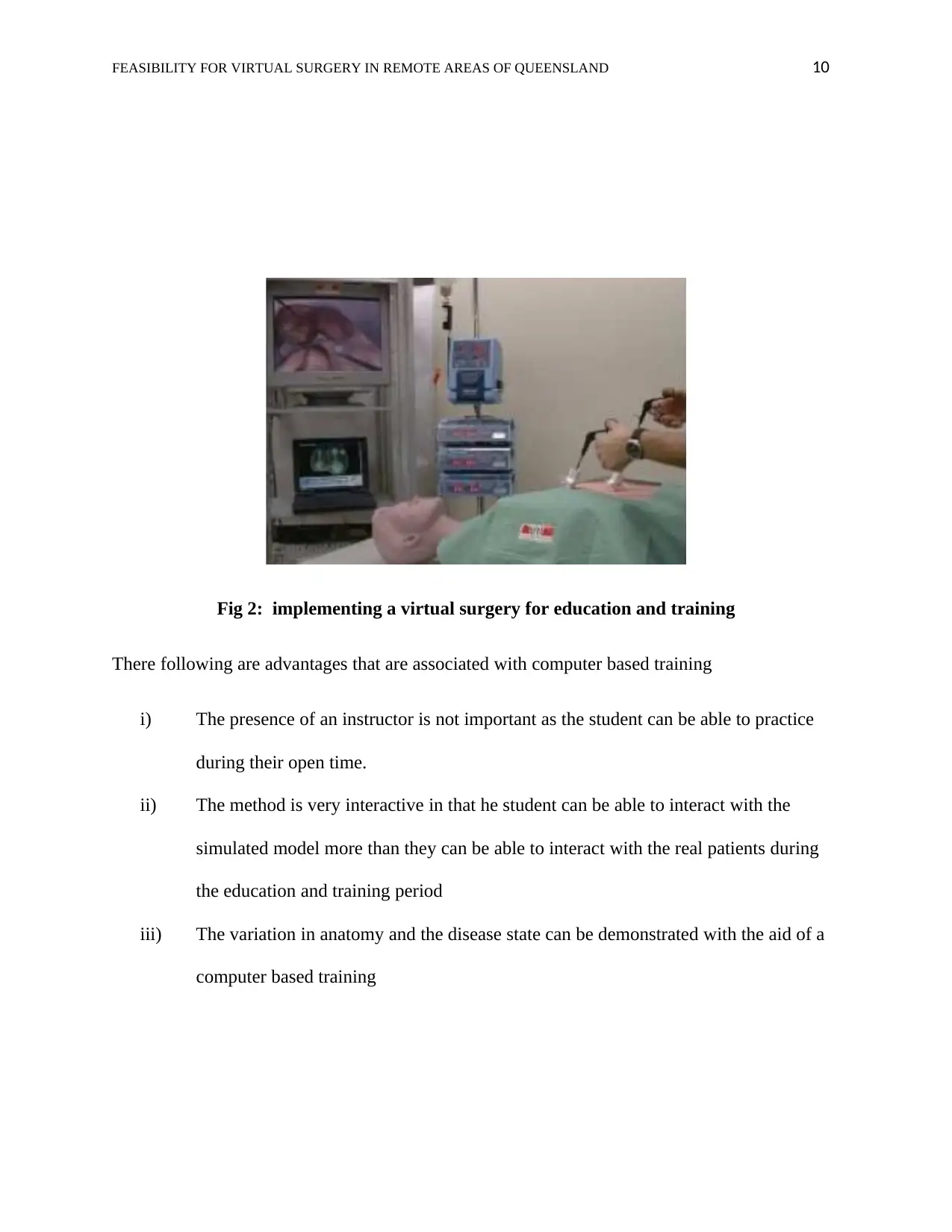
FEASIBILITY FOR VIRTUAL SURGERY IN REMOTE AREAS OF QUEENSLAND 10
Fig 2: implementing a virtual surgery for education and training
There following are advantages that are associated with computer based training
i) The presence of an instructor is not important as the student can be able to practice
during their open time.
ii) The method is very interactive in that he student can be able to interact with the
simulated model more than they can be able to interact with the real patients during
the education and training period
iii) The variation in anatomy and the disease state can be demonstrated with the aid of a
computer based training
Fig 2: implementing a virtual surgery for education and training
There following are advantages that are associated with computer based training
i) The presence of an instructor is not important as the student can be able to practice
during their open time.
ii) The method is very interactive in that he student can be able to interact with the
simulated model more than they can be able to interact with the real patients during
the education and training period
iii) The variation in anatomy and the disease state can be demonstrated with the aid of a
computer based training
Secure Best Marks with AI Grader
Need help grading? Try our AI Grader for instant feedback on your assignments.
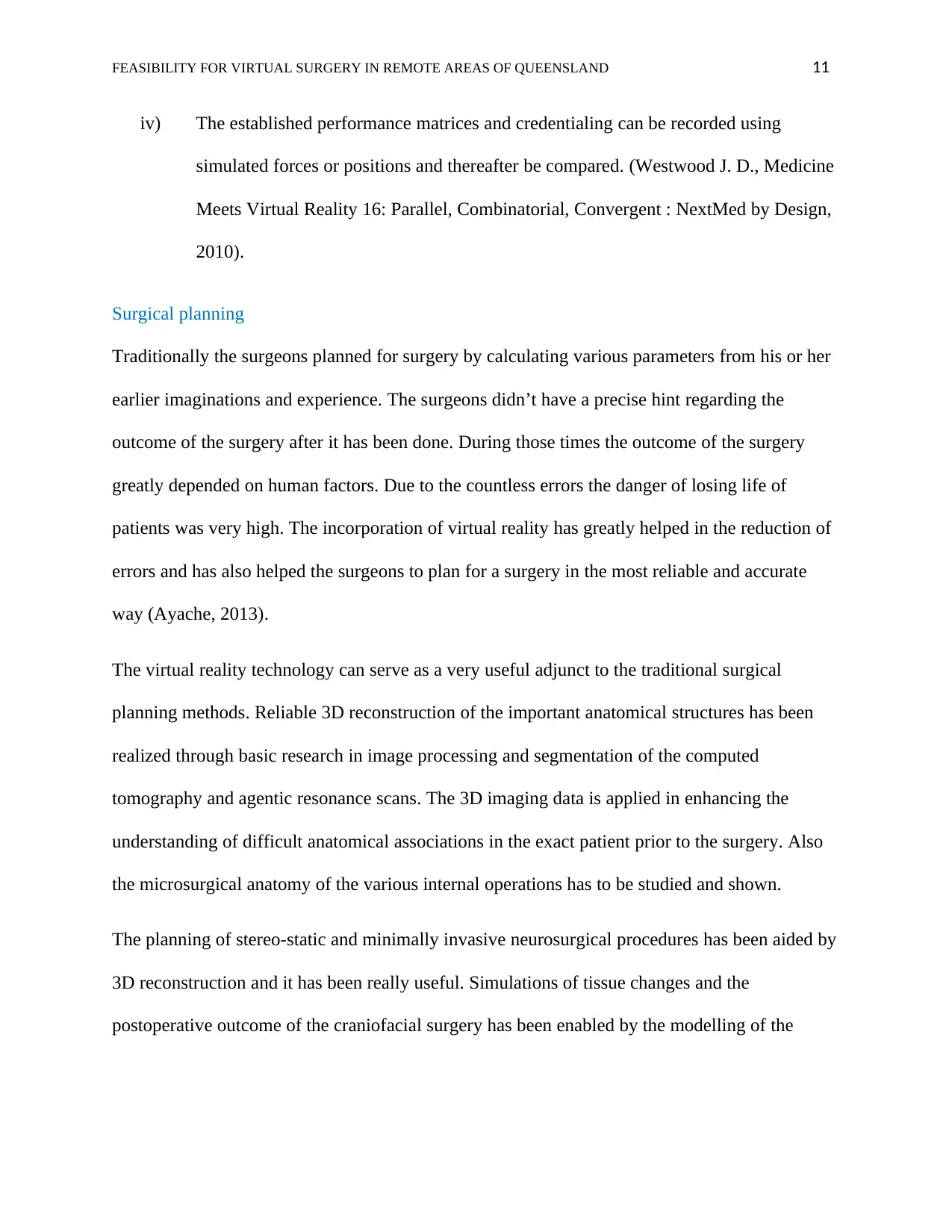
FEASIBILITY FOR VIRTUAL SURGERY IN REMOTE AREAS OF QUEENSLAND 11
iv) The established performance matrices and credentialing can be recorded using
simulated forces or positions and thereafter be compared. (Westwood J. D., Medicine
Meets Virtual Reality 16: Parallel, Combinatorial, Convergent : NextMed by Design,
2010).
Surgical planning
Traditionally the surgeons planned for surgery by calculating various parameters from his or her
earlier imaginations and experience. The surgeons didn’t have a precise hint regarding the
outcome of the surgery after it has been done. During those times the outcome of the surgery
greatly depended on human factors. Due to the countless errors the danger of losing life of
patients was very high. The incorporation of virtual reality has greatly helped in the reduction of
errors and has also helped the surgeons to plan for a surgery in the most reliable and accurate
way (Ayache, 2013).
The virtual reality technology can serve as a very useful adjunct to the traditional surgical
planning methods. Reliable 3D reconstruction of the important anatomical structures has been
realized through basic research in image processing and segmentation of the computed
tomography and agentic resonance scans. The 3D imaging data is applied in enhancing the
understanding of difficult anatomical associations in the exact patient prior to the surgery. Also
the microsurgical anatomy of the various internal operations has to be studied and shown.
The planning of stereo-static and minimally invasive neurosurgical procedures has been aided by
3D reconstruction and it has been really useful. Simulations of tissue changes and the
postoperative outcome of the craniofacial surgery has been enabled by the modelling of the
iv) The established performance matrices and credentialing can be recorded using
simulated forces or positions and thereafter be compared. (Westwood J. D., Medicine
Meets Virtual Reality 16: Parallel, Combinatorial, Convergent : NextMed by Design,
2010).
Surgical planning
Traditionally the surgeons planned for surgery by calculating various parameters from his or her
earlier imaginations and experience. The surgeons didn’t have a precise hint regarding the
outcome of the surgery after it has been done. During those times the outcome of the surgery
greatly depended on human factors. Due to the countless errors the danger of losing life of
patients was very high. The incorporation of virtual reality has greatly helped in the reduction of
errors and has also helped the surgeons to plan for a surgery in the most reliable and accurate
way (Ayache, 2013).
The virtual reality technology can serve as a very useful adjunct to the traditional surgical
planning methods. Reliable 3D reconstruction of the important anatomical structures has been
realized through basic research in image processing and segmentation of the computed
tomography and agentic resonance scans. The 3D imaging data is applied in enhancing the
understanding of difficult anatomical associations in the exact patient prior to the surgery. Also
the microsurgical anatomy of the various internal operations has to be studied and shown.
The planning of stereo-static and minimally invasive neurosurgical procedures has been aided by
3D reconstruction and it has been really useful. Simulations of tissue changes and the
postoperative outcome of the craniofacial surgery has been enabled by the modelling of the
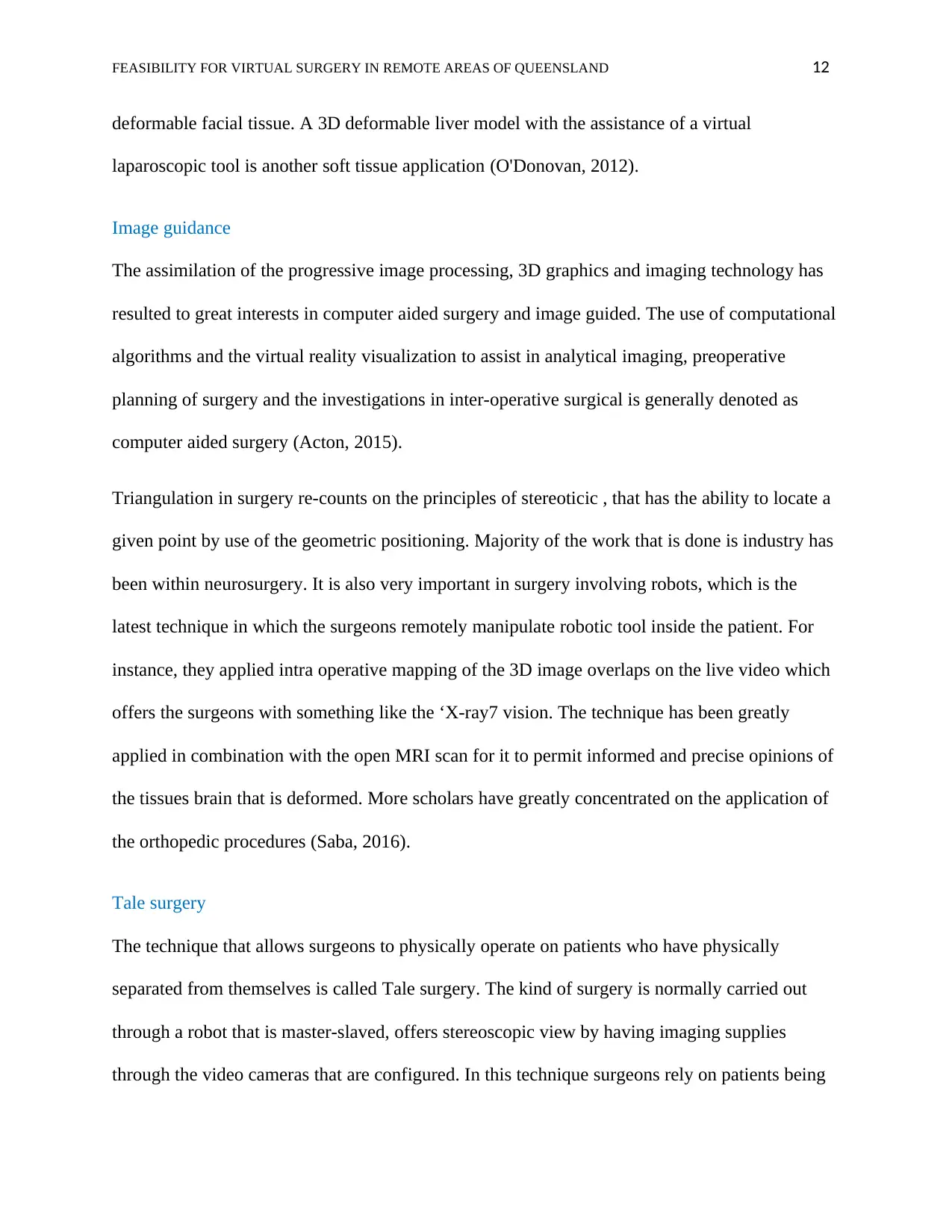
FEASIBILITY FOR VIRTUAL SURGERY IN REMOTE AREAS OF QUEENSLAND 12
deformable facial tissue. A 3D deformable liver model with the assistance of a virtual
laparoscopic tool is another soft tissue application (O'Donovan, 2012).
Image guidance
The assimilation of the progressive image processing, 3D graphics and imaging technology has
resulted to great interests in computer aided surgery and image guided. The use of computational
algorithms and the virtual reality visualization to assist in analytical imaging, preoperative
planning of surgery and the investigations in inter-operative surgical is generally denoted as
computer aided surgery (Acton, 2015).
Triangulation in surgery re-counts on the principles of stereoticic , that has the ability to locate a
given point by use of the geometric positioning. Majority of the work that is done is industry has
been within neurosurgery. It is also very important in surgery involving robots, which is the
latest technique in which the surgeons remotely manipulate robotic tool inside the patient. For
instance, they applied intra operative mapping of the 3D image overlaps on the live video which
offers the surgeons with something like the ‘X-ray7 vision. The technique has been greatly
applied in combination with the open MRI scan for it to permit informed and precise opinions of
the tissues brain that is deformed. More scholars have greatly concentrated on the application of
the orthopedic procedures (Saba, 2016).
Tale surgery
The technique that allows surgeons to physically operate on patients who have physically
separated from themselves is called Tale surgery. The kind of surgery is normally carried out
through a robot that is master-slaved, offers stereoscopic view by having imaging supplies
through the video cameras that are configured. In this technique surgeons rely on patients being
deformable facial tissue. A 3D deformable liver model with the assistance of a virtual
laparoscopic tool is another soft tissue application (O'Donovan, 2012).
Image guidance
The assimilation of the progressive image processing, 3D graphics and imaging technology has
resulted to great interests in computer aided surgery and image guided. The use of computational
algorithms and the virtual reality visualization to assist in analytical imaging, preoperative
planning of surgery and the investigations in inter-operative surgical is generally denoted as
computer aided surgery (Acton, 2015).
Triangulation in surgery re-counts on the principles of stereoticic , that has the ability to locate a
given point by use of the geometric positioning. Majority of the work that is done is industry has
been within neurosurgery. It is also very important in surgery involving robots, which is the
latest technique in which the surgeons remotely manipulate robotic tool inside the patient. For
instance, they applied intra operative mapping of the 3D image overlaps on the live video which
offers the surgeons with something like the ‘X-ray7 vision. The technique has been greatly
applied in combination with the open MRI scan for it to permit informed and precise opinions of
the tissues brain that is deformed. More scholars have greatly concentrated on the application of
the orthopedic procedures (Saba, 2016).
Tale surgery
The technique that allows surgeons to physically operate on patients who have physically
separated from themselves is called Tale surgery. The kind of surgery is normally carried out
through a robot that is master-slaved, offers stereoscopic view by having imaging supplies
through the video cameras that are configured. In this technique surgeons rely on patients being
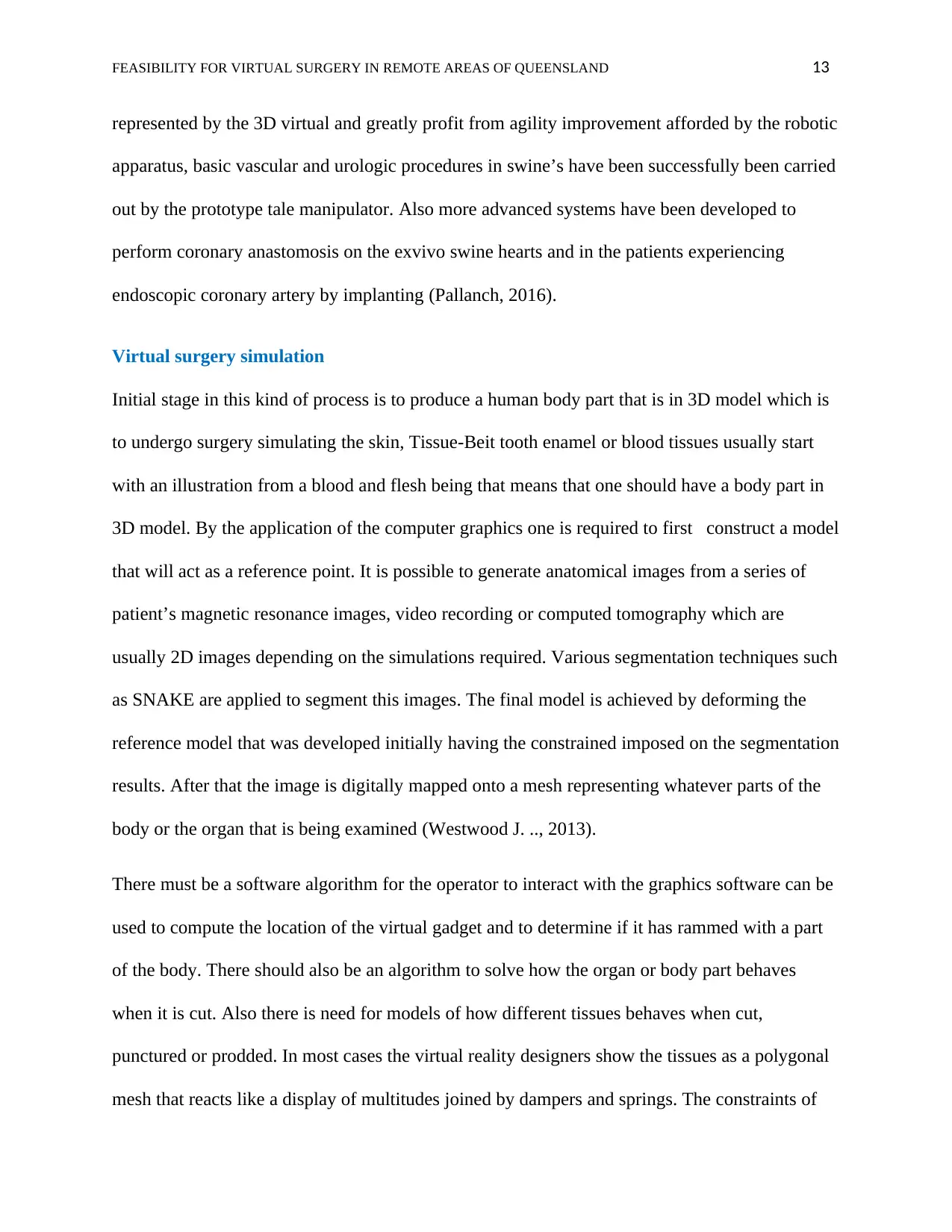
FEASIBILITY FOR VIRTUAL SURGERY IN REMOTE AREAS OF QUEENSLAND 13
represented by the 3D virtual and greatly profit from agility improvement afforded by the robotic
apparatus, basic vascular and urologic procedures in swine’s have been successfully been carried
out by the prototype tale manipulator. Also more advanced systems have been developed to
perform coronary anastomosis on the exvivo swine hearts and in the patients experiencing
endoscopic coronary artery by implanting (Pallanch, 2016).
Virtual surgery simulation
Initial stage in this kind of process is to produce a human body part that is in 3D model which is
to undergo surgery simulating the skin, Tissue-Beit tooth enamel or blood tissues usually start
with an illustration from a blood and flesh being that means that one should have a body part in
3D model. By the application of the computer graphics one is required to first construct a model
that will act as a reference point. It is possible to generate anatomical images from a series of
patient’s magnetic resonance images, video recording or computed tomography which are
usually 2D images depending on the simulations required. Various segmentation techniques such
as SNAKE are applied to segment this images. The final model is achieved by deforming the
reference model that was developed initially having the constrained imposed on the segmentation
results. After that the image is digitally mapped onto a mesh representing whatever parts of the
body or the organ that is being examined (Westwood J. .., 2013).
There must be a software algorithm for the operator to interact with the graphics software can be
used to compute the location of the virtual gadget and to determine if it has rammed with a part
of the body. There should also be an algorithm to solve how the organ or body part behaves
when it is cut. Also there is need for models of how different tissues behaves when cut,
punctured or prodded. In most cases the virtual reality designers show the tissues as a polygonal
mesh that reacts like a display of multitudes joined by dampers and springs. The constraints of
represented by the 3D virtual and greatly profit from agility improvement afforded by the robotic
apparatus, basic vascular and urologic procedures in swine’s have been successfully been carried
out by the prototype tale manipulator. Also more advanced systems have been developed to
perform coronary anastomosis on the exvivo swine hearts and in the patients experiencing
endoscopic coronary artery by implanting (Pallanch, 2016).
Virtual surgery simulation
Initial stage in this kind of process is to produce a human body part that is in 3D model which is
to undergo surgery simulating the skin, Tissue-Beit tooth enamel or blood tissues usually start
with an illustration from a blood and flesh being that means that one should have a body part in
3D model. By the application of the computer graphics one is required to first construct a model
that will act as a reference point. It is possible to generate anatomical images from a series of
patient’s magnetic resonance images, video recording or computed tomography which are
usually 2D images depending on the simulations required. Various segmentation techniques such
as SNAKE are applied to segment this images. The final model is achieved by deforming the
reference model that was developed initially having the constrained imposed on the segmentation
results. After that the image is digitally mapped onto a mesh representing whatever parts of the
body or the organ that is being examined (Westwood J. .., 2013).
There must be a software algorithm for the operator to interact with the graphics software can be
used to compute the location of the virtual gadget and to determine if it has rammed with a part
of the body. There should also be an algorithm to solve how the organ or body part behaves
when it is cut. Also there is need for models of how different tissues behaves when cut,
punctured or prodded. In most cases the virtual reality designers show the tissues as a polygonal
mesh that reacts like a display of multitudes joined by dampers and springs. The constraints of
Paraphrase This Document
Need a fresh take? Get an instant paraphrase of this document with our AI Paraphraser
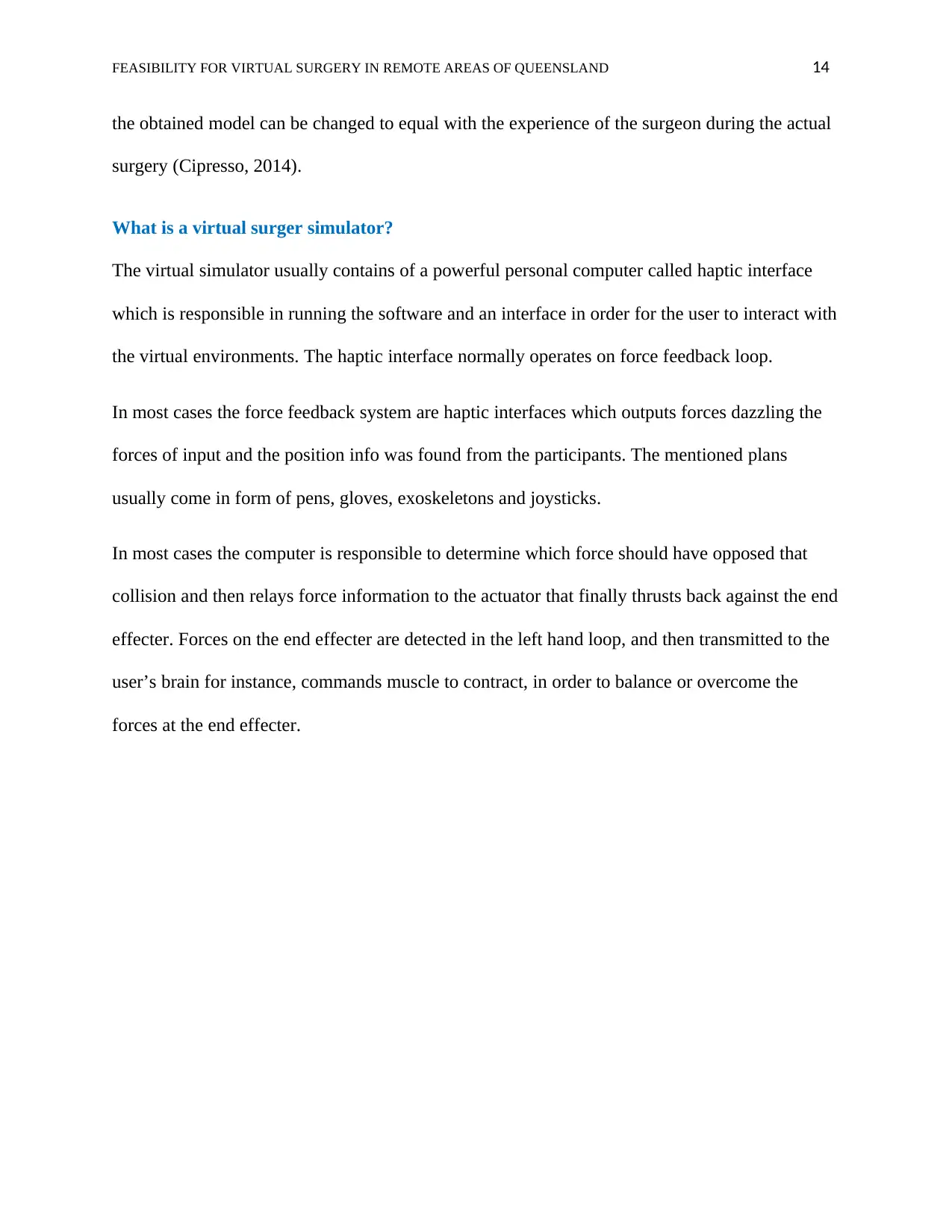
FEASIBILITY FOR VIRTUAL SURGERY IN REMOTE AREAS OF QUEENSLAND 14
the obtained model can be changed to equal with the experience of the surgeon during the actual
surgery (Cipresso, 2014).
What is a virtual surger simulator?
The virtual simulator usually contains of a powerful personal computer called haptic interface
which is responsible in running the software and an interface in order for the user to interact with
the virtual environments. The haptic interface normally operates on force feedback loop.
In most cases the force feedback system are haptic interfaces which outputs forces dazzling the
forces of input and the position info was found from the participants. The mentioned plans
usually come in form of pens, gloves, exoskeletons and joysticks.
In most cases the computer is responsible to determine which force should have opposed that
collision and then relays force information to the actuator that finally thrusts back against the end
effecter. Forces on the end effecter are detected in the left hand loop, and then transmitted to the
user’s brain for instance, commands muscle to contract, in order to balance or overcome the
forces at the end effecter.
the obtained model can be changed to equal with the experience of the surgeon during the actual
surgery (Cipresso, 2014).
What is a virtual surger simulator?
The virtual simulator usually contains of a powerful personal computer called haptic interface
which is responsible in running the software and an interface in order for the user to interact with
the virtual environments. The haptic interface normally operates on force feedback loop.
In most cases the force feedback system are haptic interfaces which outputs forces dazzling the
forces of input and the position info was found from the participants. The mentioned plans
usually come in form of pens, gloves, exoskeletons and joysticks.
In most cases the computer is responsible to determine which force should have opposed that
collision and then relays force information to the actuator that finally thrusts back against the end
effecter. Forces on the end effecter are detected in the left hand loop, and then transmitted to the
user’s brain for instance, commands muscle to contract, in order to balance or overcome the
forces at the end effecter.
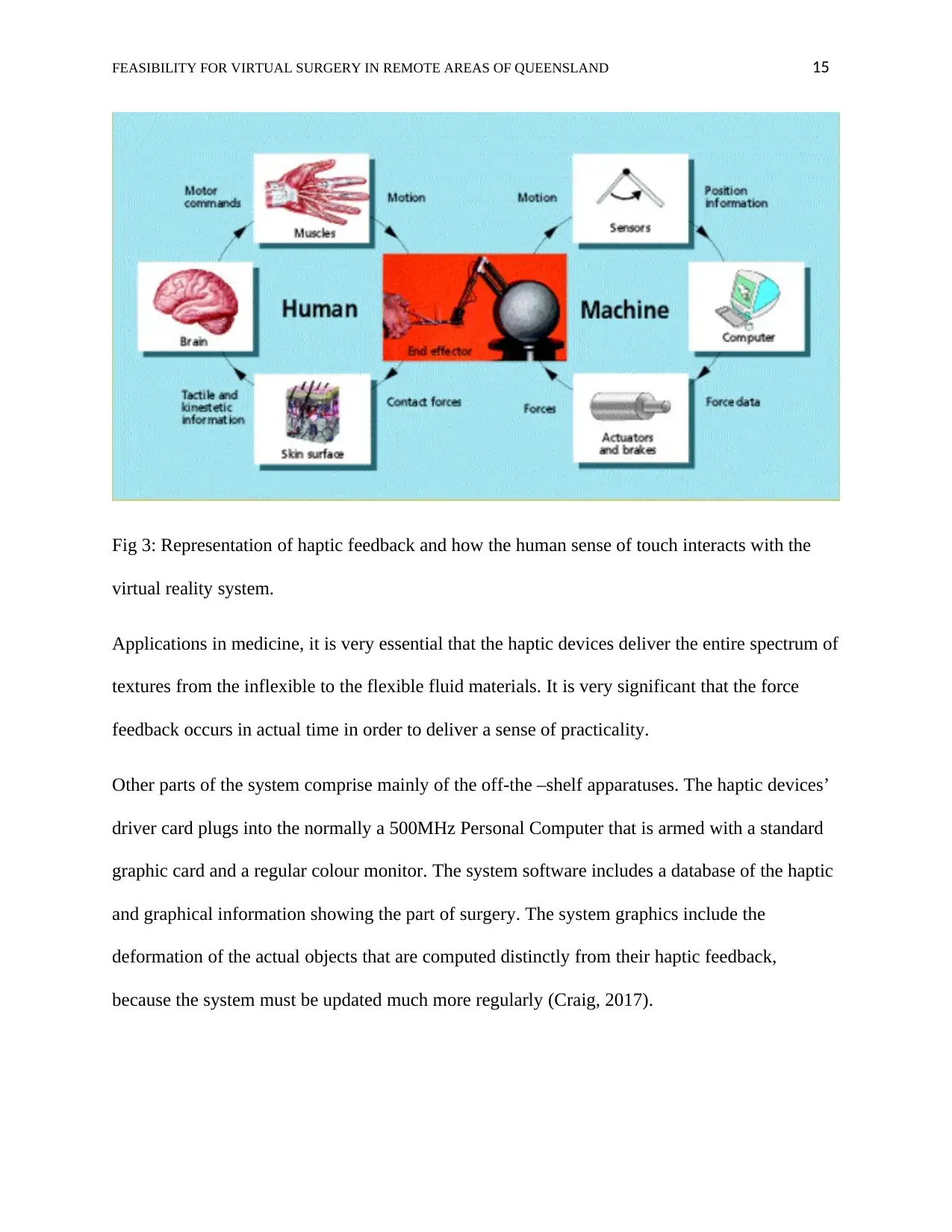
FEASIBILITY FOR VIRTUAL SURGERY IN REMOTE AREAS OF QUEENSLAND 15
Fig 3: Representation of haptic feedback and how the human sense of touch interacts with the
virtual reality system.
Applications in medicine, it is very essential that the haptic devices deliver the entire spectrum of
textures from the inflexible to the flexible fluid materials. It is very significant that the force
feedback occurs in actual time in order to deliver a sense of practicality.
Other parts of the system comprise mainly of the off-the –shelf apparatuses. The haptic devices’
driver card plugs into the normally a 500MHz Personal Computer that is armed with a standard
graphic card and a regular colour monitor. The system software includes a database of the haptic
and graphical information showing the part of surgery. The system graphics include the
deformation of the actual objects that are computed distinctly from their haptic feedback,
because the system must be updated much more regularly (Craig, 2017).
Fig 3: Representation of haptic feedback and how the human sense of touch interacts with the
virtual reality system.
Applications in medicine, it is very essential that the haptic devices deliver the entire spectrum of
textures from the inflexible to the flexible fluid materials. It is very significant that the force
feedback occurs in actual time in order to deliver a sense of practicality.
Other parts of the system comprise mainly of the off-the –shelf apparatuses. The haptic devices’
driver card plugs into the normally a 500MHz Personal Computer that is armed with a standard
graphic card and a regular colour monitor. The system software includes a database of the haptic
and graphical information showing the part of surgery. The system graphics include the
deformation of the actual objects that are computed distinctly from their haptic feedback,
because the system must be updated much more regularly (Craig, 2017).
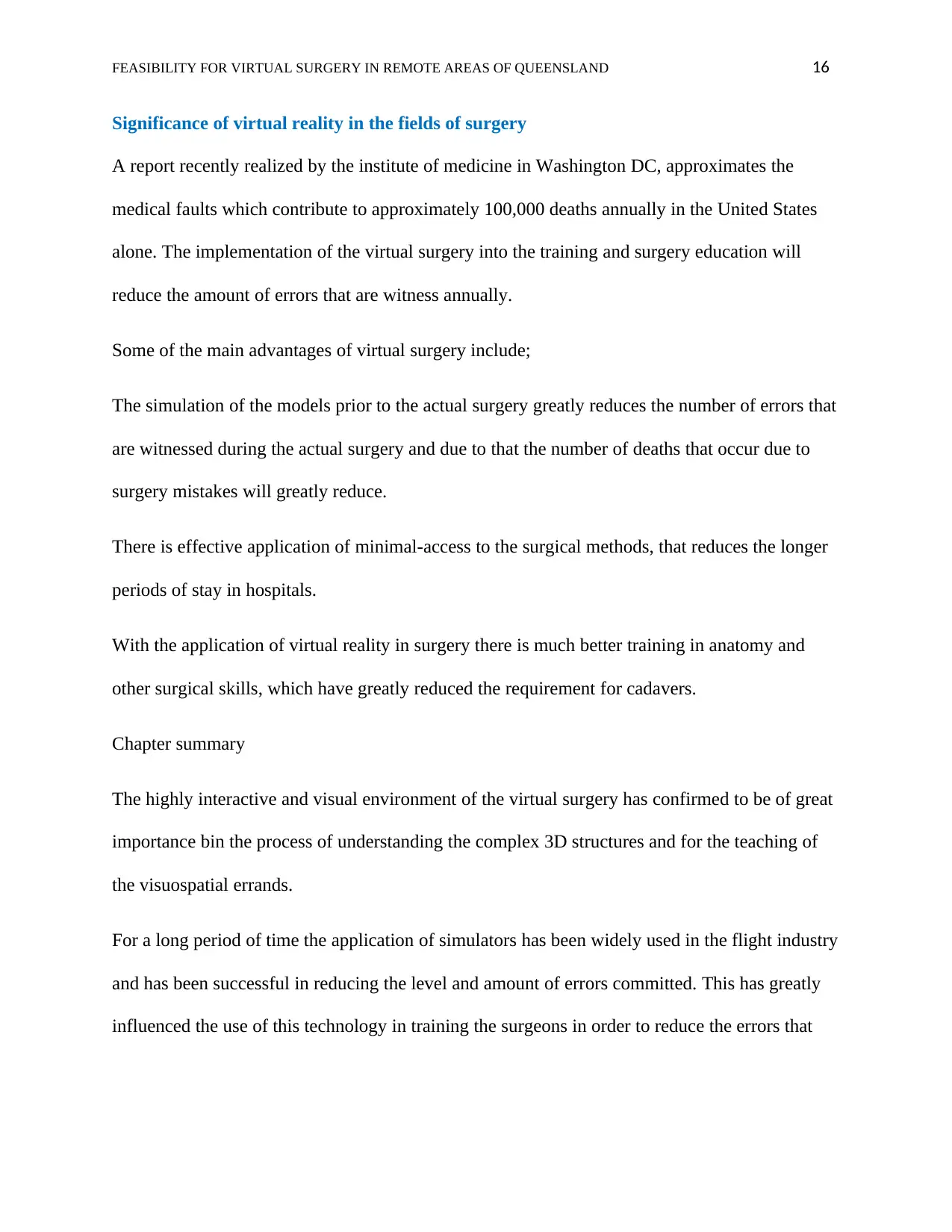
FEASIBILITY FOR VIRTUAL SURGERY IN REMOTE AREAS OF QUEENSLAND 16
Significance of virtual reality in the fields of surgery
A report recently realized by the institute of medicine in Washington DC, approximates the
medical faults which contribute to approximately 100,000 deaths annually in the United States
alone. The implementation of the virtual surgery into the training and surgery education will
reduce the amount of errors that are witness annually.
Some of the main advantages of virtual surgery include;
The simulation of the models prior to the actual surgery greatly reduces the number of errors that
are witnessed during the actual surgery and due to that the number of deaths that occur due to
surgery mistakes will greatly reduce.
There is effective application of minimal-access to the surgical methods, that reduces the longer
periods of stay in hospitals.
With the application of virtual reality in surgery there is much better training in anatomy and
other surgical skills, which have greatly reduced the requirement for cadavers.
Chapter summary
The highly interactive and visual environment of the virtual surgery has confirmed to be of great
importance bin the process of understanding the complex 3D structures and for the teaching of
the visuospatial errands.
For a long period of time the application of simulators has been widely used in the flight industry
and has been successful in reducing the level and amount of errors committed. This has greatly
influenced the use of this technology in training the surgeons in order to reduce the errors that
Significance of virtual reality in the fields of surgery
A report recently realized by the institute of medicine in Washington DC, approximates the
medical faults which contribute to approximately 100,000 deaths annually in the United States
alone. The implementation of the virtual surgery into the training and surgery education will
reduce the amount of errors that are witness annually.
Some of the main advantages of virtual surgery include;
The simulation of the models prior to the actual surgery greatly reduces the number of errors that
are witnessed during the actual surgery and due to that the number of deaths that occur due to
surgery mistakes will greatly reduce.
There is effective application of minimal-access to the surgical methods, that reduces the longer
periods of stay in hospitals.
With the application of virtual reality in surgery there is much better training in anatomy and
other surgical skills, which have greatly reduced the requirement for cadavers.
Chapter summary
The highly interactive and visual environment of the virtual surgery has confirmed to be of great
importance bin the process of understanding the complex 3D structures and for the teaching of
the visuospatial errands.
For a long period of time the application of simulators has been widely used in the flight industry
and has been successful in reducing the level and amount of errors committed. This has greatly
influenced the use of this technology in training the surgeons in order to reduce the errors that
Secure Best Marks with AI Grader
Need help grading? Try our AI Grader for instant feedback on your assignments.
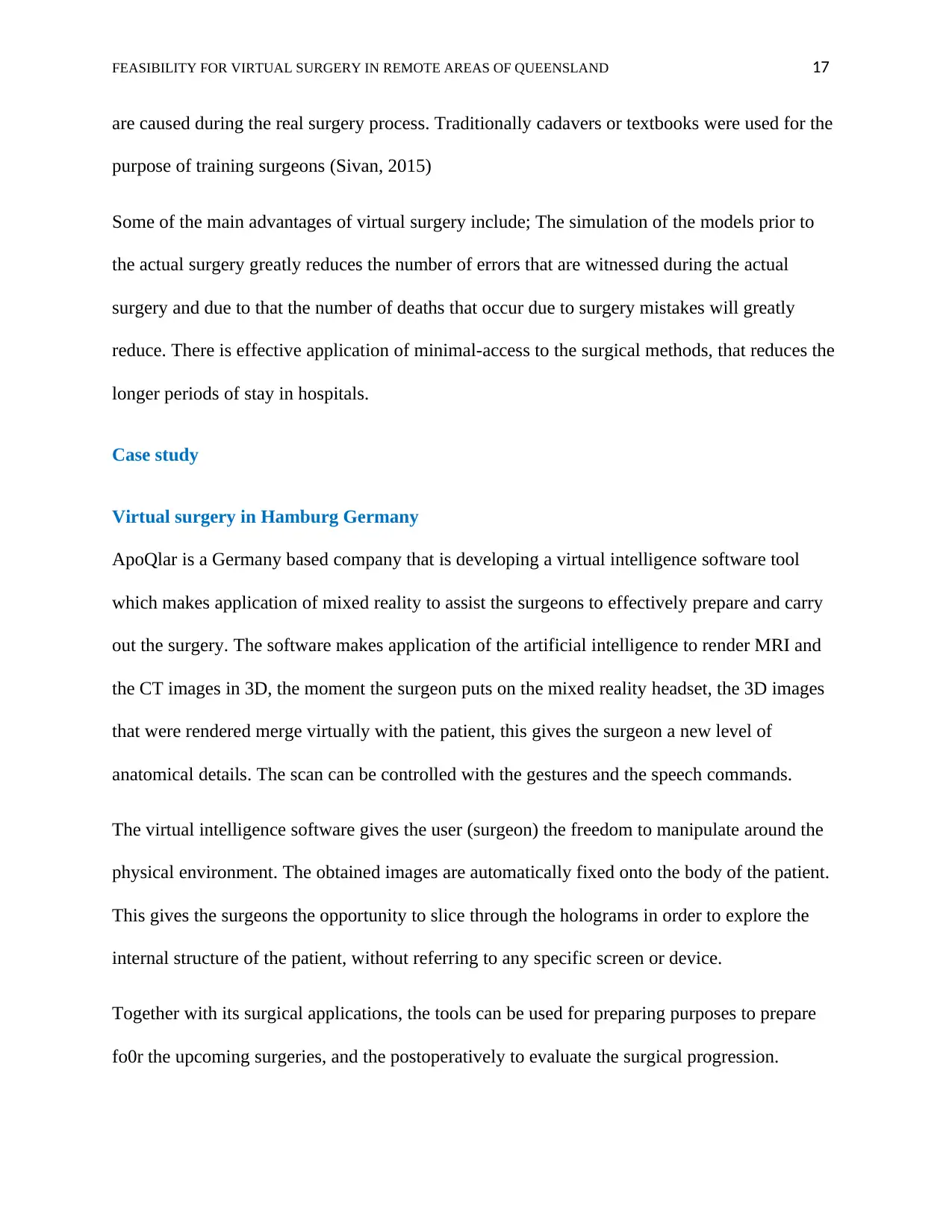
FEASIBILITY FOR VIRTUAL SURGERY IN REMOTE AREAS OF QUEENSLAND 17
are caused during the real surgery process. Traditionally cadavers or textbooks were used for the
purpose of training surgeons (Sivan, 2015)
Some of the main advantages of virtual surgery include; The simulation of the models prior to
the actual surgery greatly reduces the number of errors that are witnessed during the actual
surgery and due to that the number of deaths that occur due to surgery mistakes will greatly
reduce. There is effective application of minimal-access to the surgical methods, that reduces the
longer periods of stay in hospitals.
Case study
Virtual surgery in Hamburg Germany
ApoQlar is a Germany based company that is developing a virtual intelligence software tool
which makes application of mixed reality to assist the surgeons to effectively prepare and carry
out the surgery. The software makes application of the artificial intelligence to render MRI and
the CT images in 3D, the moment the surgeon puts on the mixed reality headset, the 3D images
that were rendered merge virtually with the patient, this gives the surgeon a new level of
anatomical details. The scan can be controlled with the gestures and the speech commands.
The virtual intelligence software gives the user (surgeon) the freedom to manipulate around the
physical environment. The obtained images are automatically fixed onto the body of the patient.
This gives the surgeons the opportunity to slice through the holograms in order to explore the
internal structure of the patient, without referring to any specific screen or device.
Together with its surgical applications, the tools can be used for preparing purposes to prepare
fo0r the upcoming surgeries, and the postoperatively to evaluate the surgical progression.
are caused during the real surgery process. Traditionally cadavers or textbooks were used for the
purpose of training surgeons (Sivan, 2015)
Some of the main advantages of virtual surgery include; The simulation of the models prior to
the actual surgery greatly reduces the number of errors that are witnessed during the actual
surgery and due to that the number of deaths that occur due to surgery mistakes will greatly
reduce. There is effective application of minimal-access to the surgical methods, that reduces the
longer periods of stay in hospitals.
Case study
Virtual surgery in Hamburg Germany
ApoQlar is a Germany based company that is developing a virtual intelligence software tool
which makes application of mixed reality to assist the surgeons to effectively prepare and carry
out the surgery. The software makes application of the artificial intelligence to render MRI and
the CT images in 3D, the moment the surgeon puts on the mixed reality headset, the 3D images
that were rendered merge virtually with the patient, this gives the surgeon a new level of
anatomical details. The scan can be controlled with the gestures and the speech commands.
The virtual intelligence software gives the user (surgeon) the freedom to manipulate around the
physical environment. The obtained images are automatically fixed onto the body of the patient.
This gives the surgeons the opportunity to slice through the holograms in order to explore the
internal structure of the patient, without referring to any specific screen or device.
Together with its surgical applications, the tools can be used for preparing purposes to prepare
fo0r the upcoming surgeries, and the postoperatively to evaluate the surgical progression.
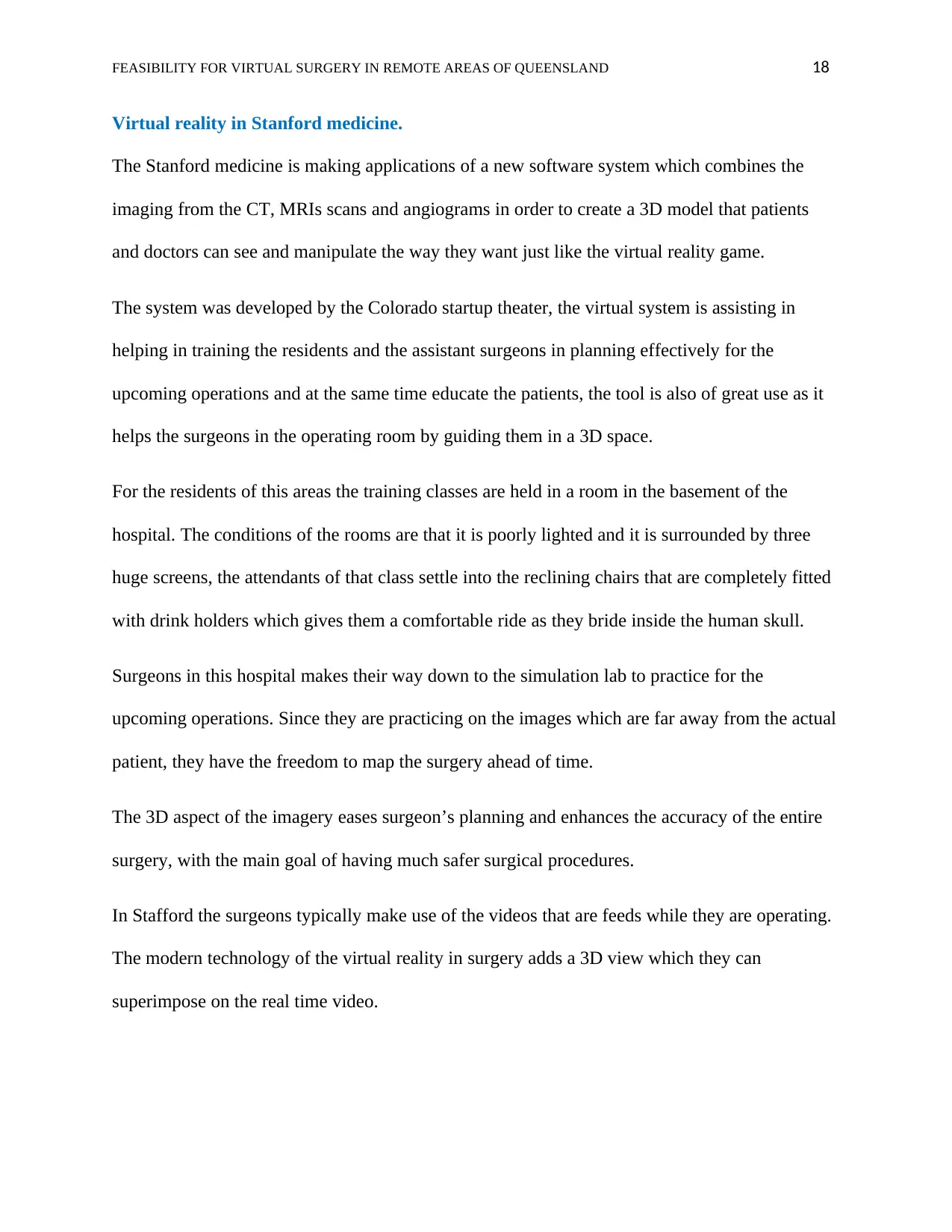
FEASIBILITY FOR VIRTUAL SURGERY IN REMOTE AREAS OF QUEENSLAND 18
Virtual reality in Stanford medicine.
The Stanford medicine is making applications of a new software system which combines the
imaging from the CT, MRIs scans and angiograms in order to create a 3D model that patients
and doctors can see and manipulate the way they want just like the virtual reality game.
The system was developed by the Colorado startup theater, the virtual system is assisting in
helping in training the residents and the assistant surgeons in planning effectively for the
upcoming operations and at the same time educate the patients, the tool is also of great use as it
helps the surgeons in the operating room by guiding them in a 3D space.
For the residents of this areas the training classes are held in a room in the basement of the
hospital. The conditions of the rooms are that it is poorly lighted and it is surrounded by three
huge screens, the attendants of that class settle into the reclining chairs that are completely fitted
with drink holders which gives them a comfortable ride as they bride inside the human skull.
Surgeons in this hospital makes their way down to the simulation lab to practice for the
upcoming operations. Since they are practicing on the images which are far away from the actual
patient, they have the freedom to map the surgery ahead of time.
The 3D aspect of the imagery eases surgeon’s planning and enhances the accuracy of the entire
surgery, with the main goal of having much safer surgical procedures.
In Stafford the surgeons typically make use of the videos that are feeds while they are operating.
The modern technology of the virtual reality in surgery adds a 3D view which they can
superimpose on the real time video.
Virtual reality in Stanford medicine.
The Stanford medicine is making applications of a new software system which combines the
imaging from the CT, MRIs scans and angiograms in order to create a 3D model that patients
and doctors can see and manipulate the way they want just like the virtual reality game.
The system was developed by the Colorado startup theater, the virtual system is assisting in
helping in training the residents and the assistant surgeons in planning effectively for the
upcoming operations and at the same time educate the patients, the tool is also of great use as it
helps the surgeons in the operating room by guiding them in a 3D space.
For the residents of this areas the training classes are held in a room in the basement of the
hospital. The conditions of the rooms are that it is poorly lighted and it is surrounded by three
huge screens, the attendants of that class settle into the reclining chairs that are completely fitted
with drink holders which gives them a comfortable ride as they bride inside the human skull.
Surgeons in this hospital makes their way down to the simulation lab to practice for the
upcoming operations. Since they are practicing on the images which are far away from the actual
patient, they have the freedom to map the surgery ahead of time.
The 3D aspect of the imagery eases surgeon’s planning and enhances the accuracy of the entire
surgery, with the main goal of having much safer surgical procedures.
In Stafford the surgeons typically make use of the videos that are feeds while they are operating.
The modern technology of the virtual reality in surgery adds a 3D view which they can
superimpose on the real time video.

FEASIBILITY FOR VIRTUAL SURGERY IN REMOTE AREAS OF QUEENSLAND 19
Doctors in Stanford are making use of this technology for the spinal cord and brain surgeries
since this organ are stable and lend themselves to imaginary, unlike the other body parts, which
move with blood flow and breathing.
Chapter summary
In summary, ApoQlar is a Germany based company that is developing a virtual intelligence
software tool which makes application of mixed reality to assist the surgeons to effectively
prepare and carry out the surgery. The software makes application of the artificial intelligence to
render MRI and the CT images in 3D, the moment the surgeon puts on the mixed reality headset,
the 3D images that were rendered merge virtually with the patient, this gives the surgeon a new
level of anatomical details.
The Stanford medicine is making applications of a new software system which combines the
imaging from the CT, MRIs scans and angiograms in order to create a 3D model that patients
and doctors can see and manipulate the way they want just like the virtual reality game. The 3D
aspect of the imagery eases surgeon’s planning and enhances the accuracy of the entire surgery,
with the main goal of having much safer surgical procedures.
Discussions
How virtual surgery will increase its use in remote areas of Queensland
The challenge of offering quality surgical procedure to people living in the remote areas of
Queensland can be discouraging. The residents of this remote area of Queensland are usually
vulnerable in terms of both health access and status, due to that there is need to highlighting the
need for innovation in how the surgical procedures are being carried out. The fast growing
Doctors in Stanford are making use of this technology for the spinal cord and brain surgeries
since this organ are stable and lend themselves to imaginary, unlike the other body parts, which
move with blood flow and breathing.
Chapter summary
In summary, ApoQlar is a Germany based company that is developing a virtual intelligence
software tool which makes application of mixed reality to assist the surgeons to effectively
prepare and carry out the surgery. The software makes application of the artificial intelligence to
render MRI and the CT images in 3D, the moment the surgeon puts on the mixed reality headset,
the 3D images that were rendered merge virtually with the patient, this gives the surgeon a new
level of anatomical details.
The Stanford medicine is making applications of a new software system which combines the
imaging from the CT, MRIs scans and angiograms in order to create a 3D model that patients
and doctors can see and manipulate the way they want just like the virtual reality game. The 3D
aspect of the imagery eases surgeon’s planning and enhances the accuracy of the entire surgery,
with the main goal of having much safer surgical procedures.
Discussions
How virtual surgery will increase its use in remote areas of Queensland
The challenge of offering quality surgical procedure to people living in the remote areas of
Queensland can be discouraging. The residents of this remote area of Queensland are usually
vulnerable in terms of both health access and status, due to that there is need to highlighting the
need for innovation in how the surgical procedures are being carried out. The fast growing
Paraphrase This Document
Need a fresh take? Get an instant paraphrase of this document with our AI Paraphraser
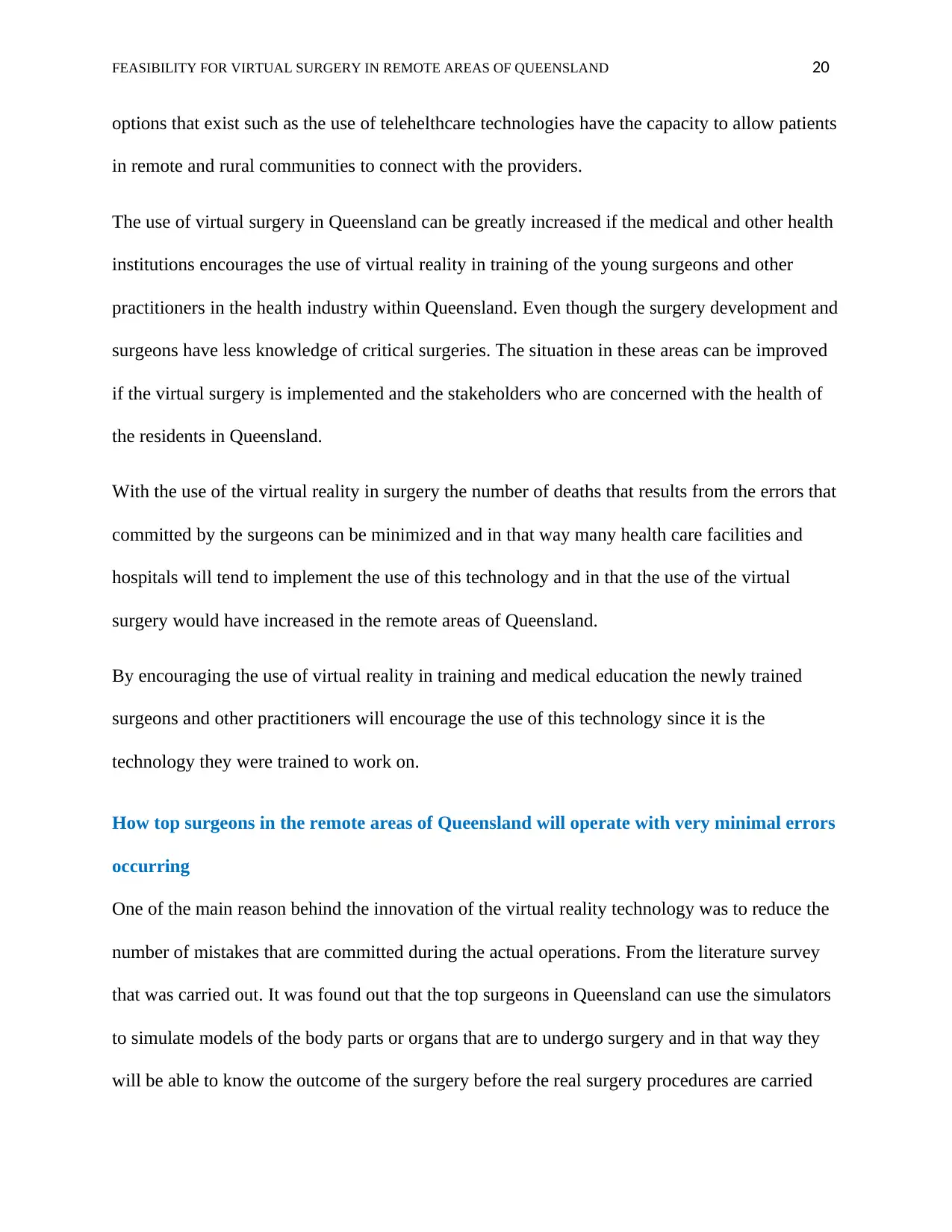
FEASIBILITY FOR VIRTUAL SURGERY IN REMOTE AREAS OF QUEENSLAND 20
options that exist such as the use of telehelthcare technologies have the capacity to allow patients
in remote and rural communities to connect with the providers.
The use of virtual surgery in Queensland can be greatly increased if the medical and other health
institutions encourages the use of virtual reality in training of the young surgeons and other
practitioners in the health industry within Queensland. Even though the surgery development and
surgeons have less knowledge of critical surgeries. The situation in these areas can be improved
if the virtual surgery is implemented and the stakeholders who are concerned with the health of
the residents in Queensland.
With the use of the virtual reality in surgery the number of deaths that results from the errors that
committed by the surgeons can be minimized and in that way many health care facilities and
hospitals will tend to implement the use of this technology and in that the use of the virtual
surgery would have increased in the remote areas of Queensland.
By encouraging the use of virtual reality in training and medical education the newly trained
surgeons and other practitioners will encourage the use of this technology since it is the
technology they were trained to work on.
How top surgeons in the remote areas of Queensland will operate with very minimal errors
occurring
One of the main reason behind the innovation of the virtual reality technology was to reduce the
number of mistakes that are committed during the actual operations. From the literature survey
that was carried out. It was found out that the top surgeons in Queensland can use the simulators
to simulate models of the body parts or organs that are to undergo surgery and in that way they
will be able to know the outcome of the surgery before the real surgery procedures are carried
options that exist such as the use of telehelthcare technologies have the capacity to allow patients
in remote and rural communities to connect with the providers.
The use of virtual surgery in Queensland can be greatly increased if the medical and other health
institutions encourages the use of virtual reality in training of the young surgeons and other
practitioners in the health industry within Queensland. Even though the surgery development and
surgeons have less knowledge of critical surgeries. The situation in these areas can be improved
if the virtual surgery is implemented and the stakeholders who are concerned with the health of
the residents in Queensland.
With the use of the virtual reality in surgery the number of deaths that results from the errors that
committed by the surgeons can be minimized and in that way many health care facilities and
hospitals will tend to implement the use of this technology and in that the use of the virtual
surgery would have increased in the remote areas of Queensland.
By encouraging the use of virtual reality in training and medical education the newly trained
surgeons and other practitioners will encourage the use of this technology since it is the
technology they were trained to work on.
How top surgeons in the remote areas of Queensland will operate with very minimal errors
occurring
One of the main reason behind the innovation of the virtual reality technology was to reduce the
number of mistakes that are committed during the actual operations. From the literature survey
that was carried out. It was found out that the top surgeons in Queensland can use the simulators
to simulate models of the body parts or organs that are to undergo surgery and in that way they
will be able to know the outcome of the surgery before the real surgery procedures are carried
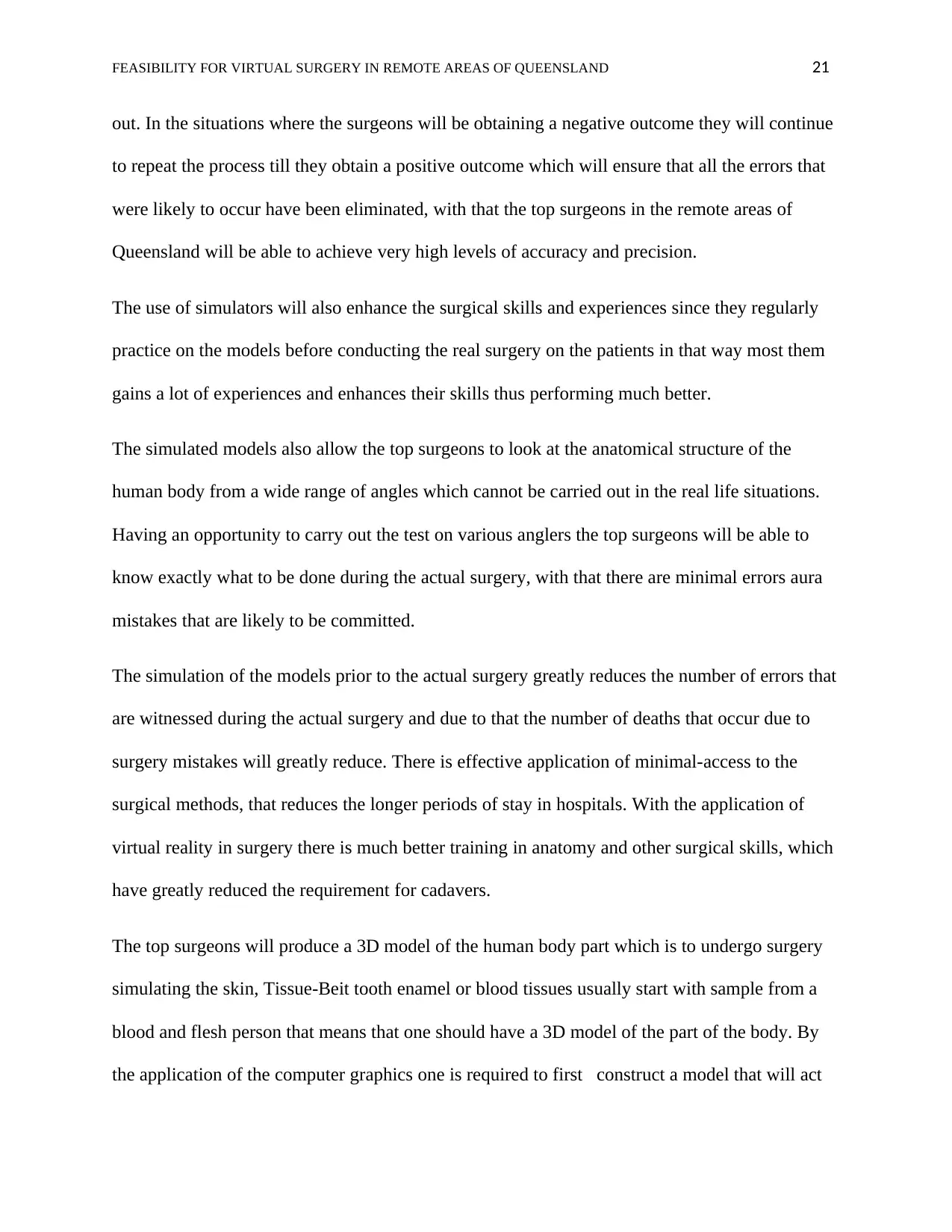
FEASIBILITY FOR VIRTUAL SURGERY IN REMOTE AREAS OF QUEENSLAND 21
out. In the situations where the surgeons will be obtaining a negative outcome they will continue
to repeat the process till they obtain a positive outcome which will ensure that all the errors that
were likely to occur have been eliminated, with that the top surgeons in the remote areas of
Queensland will be able to achieve very high levels of accuracy and precision.
The use of simulators will also enhance the surgical skills and experiences since they regularly
practice on the models before conducting the real surgery on the patients in that way most them
gains a lot of experiences and enhances their skills thus performing much better.
The simulated models also allow the top surgeons to look at the anatomical structure of the
human body from a wide range of angles which cannot be carried out in the real life situations.
Having an opportunity to carry out the test on various anglers the top surgeons will be able to
know exactly what to be done during the actual surgery, with that there are minimal errors aura
mistakes that are likely to be committed.
The simulation of the models prior to the actual surgery greatly reduces the number of errors that
are witnessed during the actual surgery and due to that the number of deaths that occur due to
surgery mistakes will greatly reduce. There is effective application of minimal-access to the
surgical methods, that reduces the longer periods of stay in hospitals. With the application of
virtual reality in surgery there is much better training in anatomy and other surgical skills, which
have greatly reduced the requirement for cadavers.
The top surgeons will produce a 3D model of the human body part which is to undergo surgery
simulating the skin, Tissue-Beit tooth enamel or blood tissues usually start with sample from a
blood and flesh person that means that one should have a 3D model of the part of the body. By
the application of the computer graphics one is required to first construct a model that will act
out. In the situations where the surgeons will be obtaining a negative outcome they will continue
to repeat the process till they obtain a positive outcome which will ensure that all the errors that
were likely to occur have been eliminated, with that the top surgeons in the remote areas of
Queensland will be able to achieve very high levels of accuracy and precision.
The use of simulators will also enhance the surgical skills and experiences since they regularly
practice on the models before conducting the real surgery on the patients in that way most them
gains a lot of experiences and enhances their skills thus performing much better.
The simulated models also allow the top surgeons to look at the anatomical structure of the
human body from a wide range of angles which cannot be carried out in the real life situations.
Having an opportunity to carry out the test on various anglers the top surgeons will be able to
know exactly what to be done during the actual surgery, with that there are minimal errors aura
mistakes that are likely to be committed.
The simulation of the models prior to the actual surgery greatly reduces the number of errors that
are witnessed during the actual surgery and due to that the number of deaths that occur due to
surgery mistakes will greatly reduce. There is effective application of minimal-access to the
surgical methods, that reduces the longer periods of stay in hospitals. With the application of
virtual reality in surgery there is much better training in anatomy and other surgical skills, which
have greatly reduced the requirement for cadavers.
The top surgeons will produce a 3D model of the human body part which is to undergo surgery
simulating the skin, Tissue-Beit tooth enamel or blood tissues usually start with sample from a
blood and flesh person that means that one should have a 3D model of the part of the body. By
the application of the computer graphics one is required to first construct a model that will act
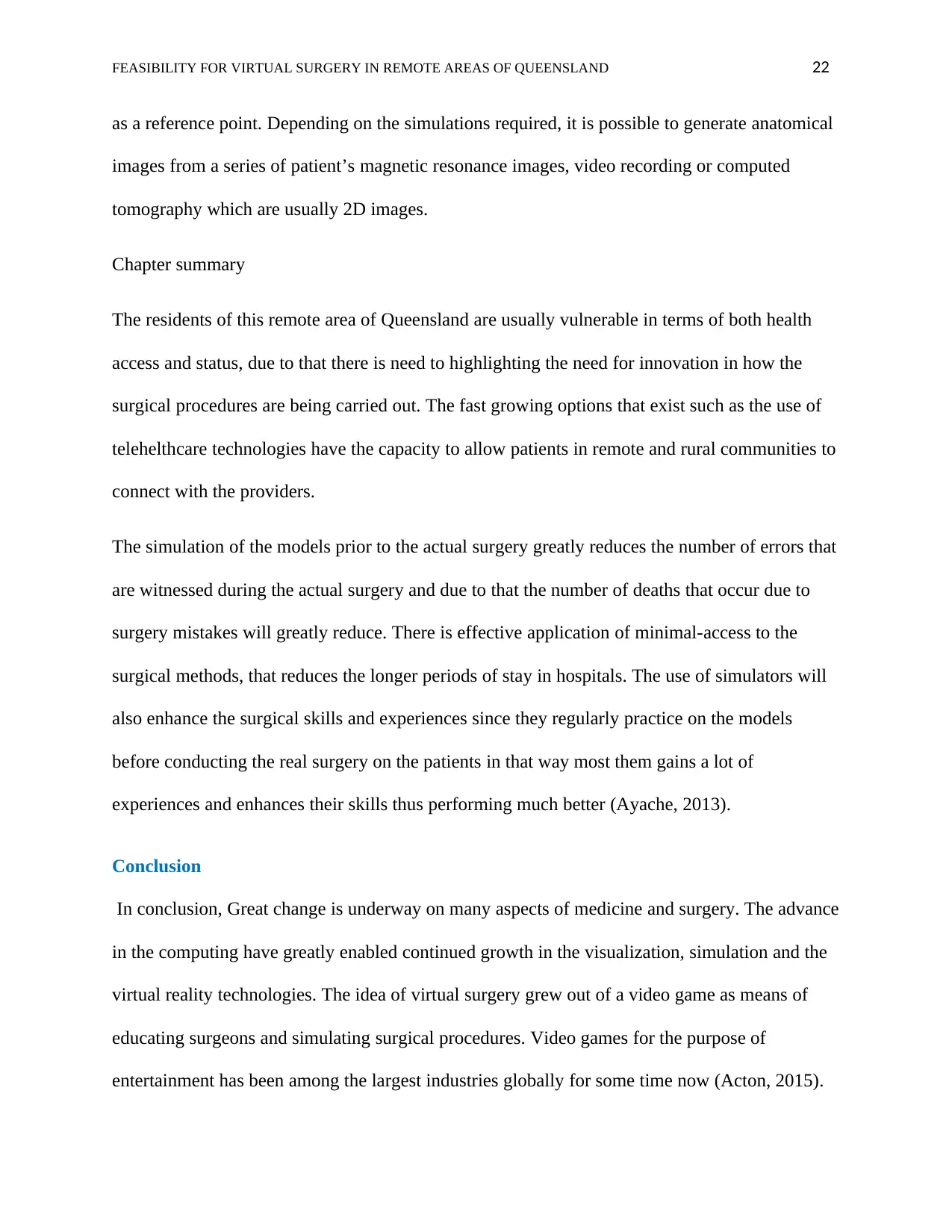
FEASIBILITY FOR VIRTUAL SURGERY IN REMOTE AREAS OF QUEENSLAND 22
as a reference point. Depending on the simulations required, it is possible to generate anatomical
images from a series of patient’s magnetic resonance images, video recording or computed
tomography which are usually 2D images.
Chapter summary
The residents of this remote area of Queensland are usually vulnerable in terms of both health
access and status, due to that there is need to highlighting the need for innovation in how the
surgical procedures are being carried out. The fast growing options that exist such as the use of
telehelthcare technologies have the capacity to allow patients in remote and rural communities to
connect with the providers.
The simulation of the models prior to the actual surgery greatly reduces the number of errors that
are witnessed during the actual surgery and due to that the number of deaths that occur due to
surgery mistakes will greatly reduce. There is effective application of minimal-access to the
surgical methods, that reduces the longer periods of stay in hospitals. The use of simulators will
also enhance the surgical skills and experiences since they regularly practice on the models
before conducting the real surgery on the patients in that way most them gains a lot of
experiences and enhances their skills thus performing much better (Ayache, 2013).
Conclusion
In conclusion, Great change is underway on many aspects of medicine and surgery. The advance
in the computing have greatly enabled continued growth in the visualization, simulation and the
virtual reality technologies. The idea of virtual surgery grew out of a video game as means of
educating surgeons and simulating surgical procedures. Video games for the purpose of
entertainment has been among the largest industries globally for some time now (Acton, 2015).
as a reference point. Depending on the simulations required, it is possible to generate anatomical
images from a series of patient’s magnetic resonance images, video recording or computed
tomography which are usually 2D images.
Chapter summary
The residents of this remote area of Queensland are usually vulnerable in terms of both health
access and status, due to that there is need to highlighting the need for innovation in how the
surgical procedures are being carried out. The fast growing options that exist such as the use of
telehelthcare technologies have the capacity to allow patients in remote and rural communities to
connect with the providers.
The simulation of the models prior to the actual surgery greatly reduces the number of errors that
are witnessed during the actual surgery and due to that the number of deaths that occur due to
surgery mistakes will greatly reduce. There is effective application of minimal-access to the
surgical methods, that reduces the longer periods of stay in hospitals. The use of simulators will
also enhance the surgical skills and experiences since they regularly practice on the models
before conducting the real surgery on the patients in that way most them gains a lot of
experiences and enhances their skills thus performing much better (Ayache, 2013).
Conclusion
In conclusion, Great change is underway on many aspects of medicine and surgery. The advance
in the computing have greatly enabled continued growth in the visualization, simulation and the
virtual reality technologies. The idea of virtual surgery grew out of a video game as means of
educating surgeons and simulating surgical procedures. Video games for the purpose of
entertainment has been among the largest industries globally for some time now (Acton, 2015).
Secure Best Marks with AI Grader
Need help grading? Try our AI Grader for instant feedback on your assignments.
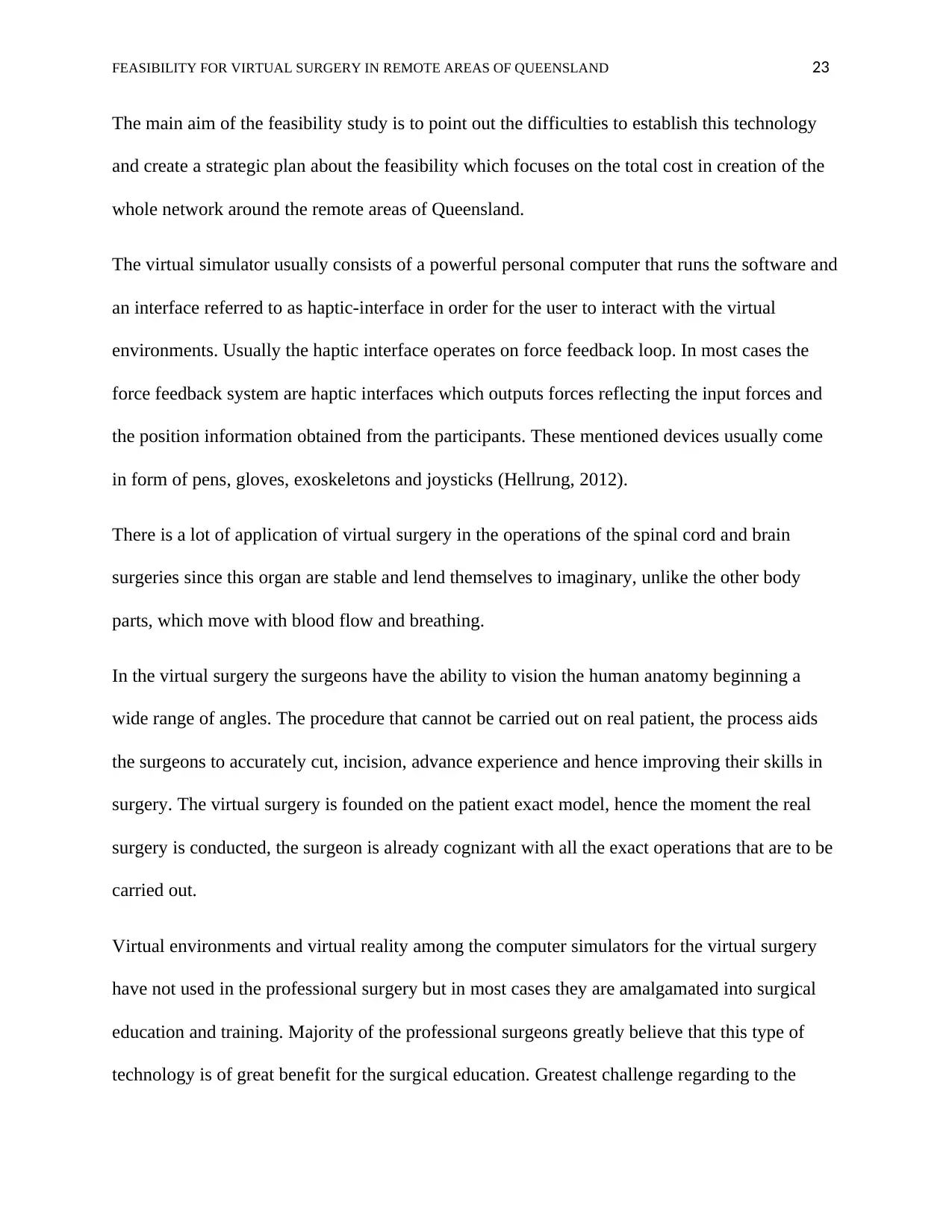
FEASIBILITY FOR VIRTUAL SURGERY IN REMOTE AREAS OF QUEENSLAND 23
The main aim of the feasibility study is to point out the difficulties to establish this technology
and create a strategic plan about the feasibility which focuses on the total cost in creation of the
whole network around the remote areas of Queensland.
The virtual simulator usually consists of a powerful personal computer that runs the software and
an interface referred to as haptic-interface in order for the user to interact with the virtual
environments. Usually the haptic interface operates on force feedback loop. In most cases the
force feedback system are haptic interfaces which outputs forces reflecting the input forces and
the position information obtained from the participants. These mentioned devices usually come
in form of pens, gloves, exoskeletons and joysticks (Hellrung, 2012).
There is a lot of application of virtual surgery in the operations of the spinal cord and brain
surgeries since this organ are stable and lend themselves to imaginary, unlike the other body
parts, which move with blood flow and breathing.
In the virtual surgery the surgeons have the ability to vision the human anatomy beginning a
wide range of angles. The procedure that cannot be carried out on real patient, the process aids
the surgeons to accurately cut, incision, advance experience and hence improving their skills in
surgery. The virtual surgery is founded on the patient exact model, hence the moment the real
surgery is conducted, the surgeon is already cognizant with all the exact operations that are to be
carried out.
Virtual environments and virtual reality among the computer simulators for the virtual surgery
have not used in the professional surgery but in most cases they are amalgamated into surgical
education and training. Majority of the professional surgeons greatly believe that this type of
technology is of great benefit for the surgical education. Greatest challenge regarding to the
The main aim of the feasibility study is to point out the difficulties to establish this technology
and create a strategic plan about the feasibility which focuses on the total cost in creation of the
whole network around the remote areas of Queensland.
The virtual simulator usually consists of a powerful personal computer that runs the software and
an interface referred to as haptic-interface in order for the user to interact with the virtual
environments. Usually the haptic interface operates on force feedback loop. In most cases the
force feedback system are haptic interfaces which outputs forces reflecting the input forces and
the position information obtained from the participants. These mentioned devices usually come
in form of pens, gloves, exoskeletons and joysticks (Hellrung, 2012).
There is a lot of application of virtual surgery in the operations of the spinal cord and brain
surgeries since this organ are stable and lend themselves to imaginary, unlike the other body
parts, which move with blood flow and breathing.
In the virtual surgery the surgeons have the ability to vision the human anatomy beginning a
wide range of angles. The procedure that cannot be carried out on real patient, the process aids
the surgeons to accurately cut, incision, advance experience and hence improving their skills in
surgery. The virtual surgery is founded on the patient exact model, hence the moment the real
surgery is conducted, the surgeon is already cognizant with all the exact operations that are to be
carried out.
Virtual environments and virtual reality among the computer simulators for the virtual surgery
have not used in the professional surgery but in most cases they are amalgamated into surgical
education and training. Majority of the professional surgeons greatly believe that this type of
technology is of great benefit for the surgical education. Greatest challenge regarding to the
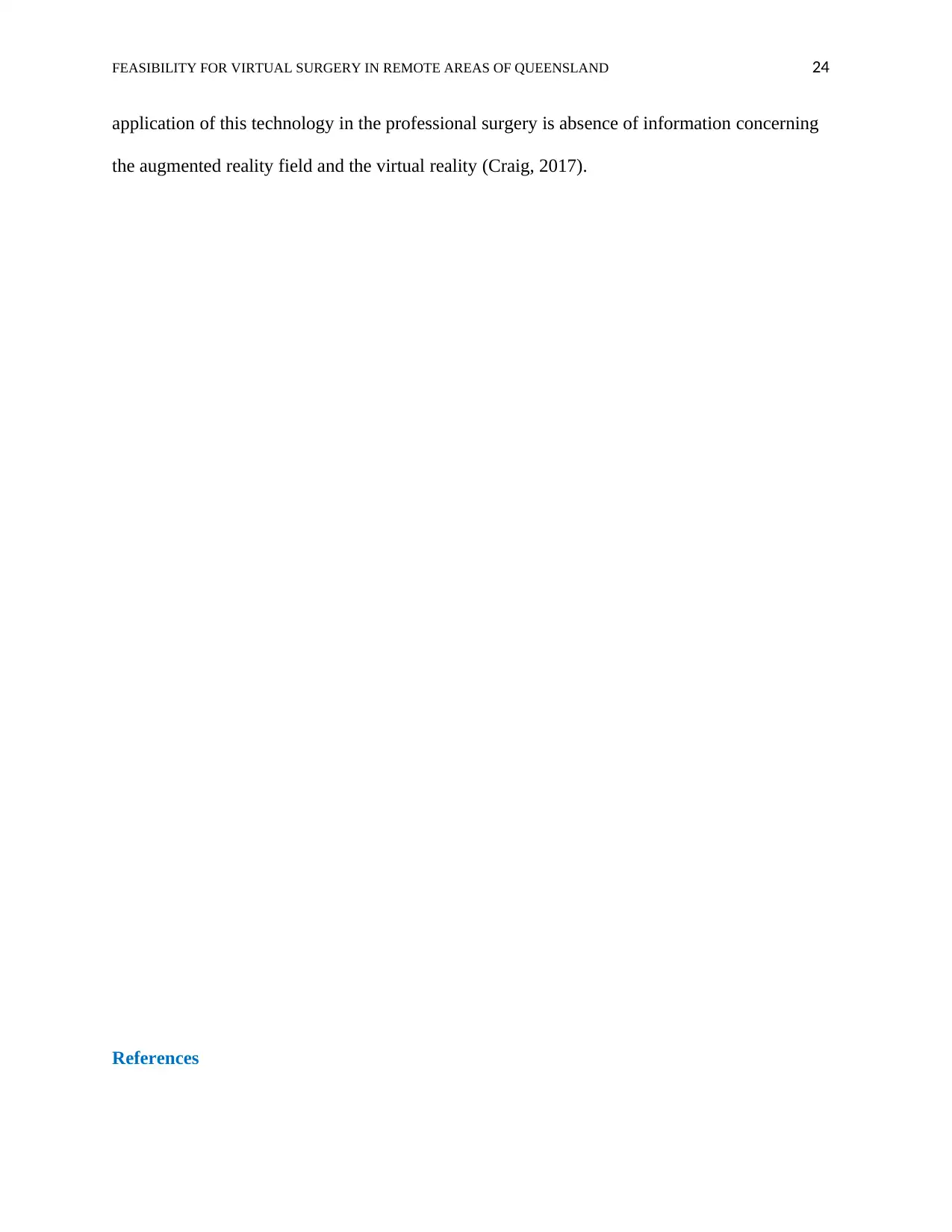
FEASIBILITY FOR VIRTUAL SURGERY IN REMOTE AREAS OF QUEENSLAND 24
application of this technology in the professional surgery is absence of information concerning
the augmented reality field and the virtual reality (Craig, 2017).
References
application of this technology in the professional surgery is absence of information concerning
the augmented reality field and the virtual reality (Craig, 2017).
References
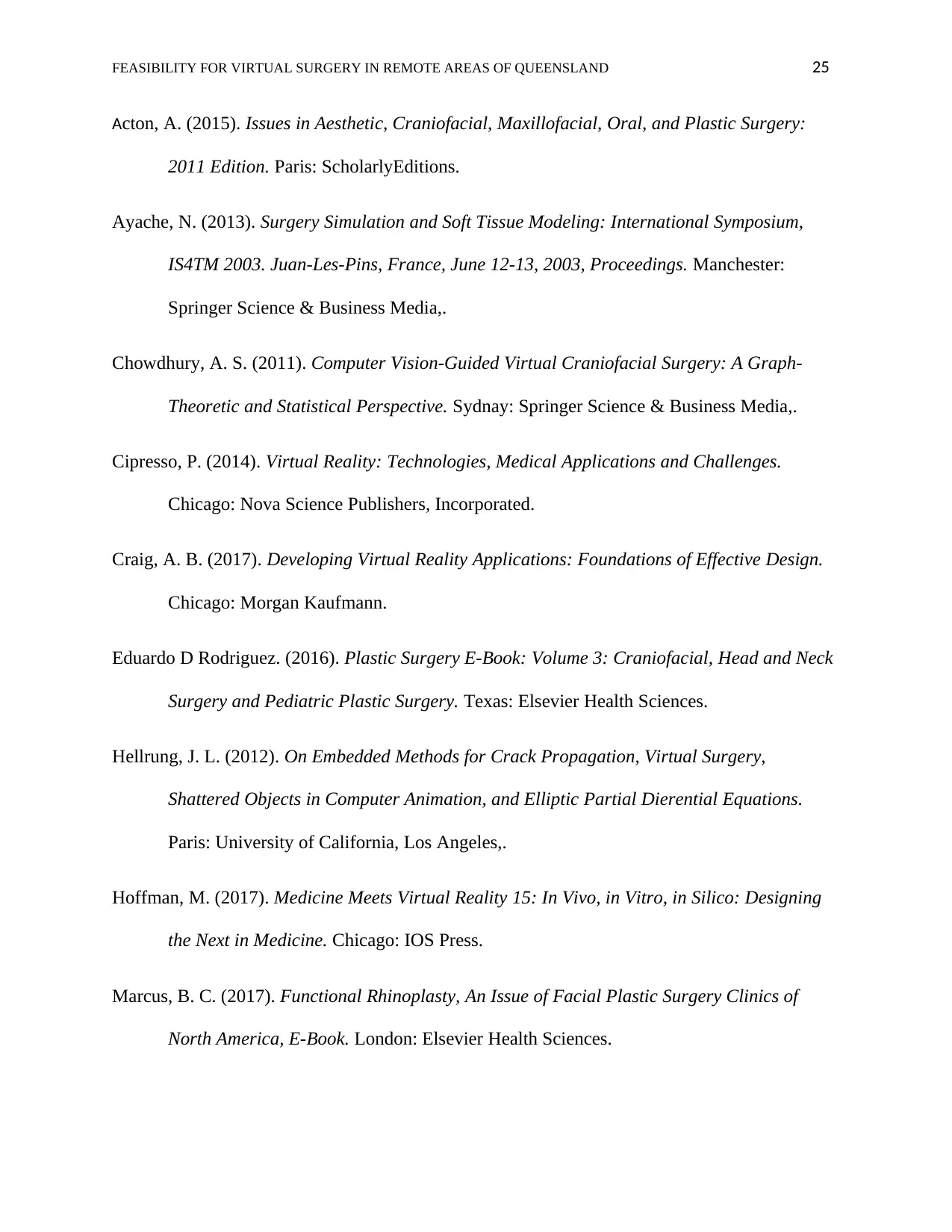
FEASIBILITY FOR VIRTUAL SURGERY IN REMOTE AREAS OF QUEENSLAND 25
Acton, A. (2015). Issues in Aesthetic, Craniofacial, Maxillofacial, Oral, and Plastic Surgery:
2011 Edition. Paris: ScholarlyEditions.
Ayache, N. (2013). Surgery Simulation and Soft Tissue Modeling: International Symposium,
IS4TM 2003. Juan-Les-Pins, France, June 12-13, 2003, Proceedings. Manchester:
Springer Science & Business Media,.
Chowdhury, A. S. (2011). Computer Vision-Guided Virtual Craniofacial Surgery: A Graph-
Theoretic and Statistical Perspective. Sydnay: Springer Science & Business Media,.
Cipresso, P. (2014). Virtual Reality: Technologies, Medical Applications and Challenges.
Chicago: Nova Science Publishers, Incorporated.
Craig, A. B. (2017). Developing Virtual Reality Applications: Foundations of Effective Design.
Chicago: Morgan Kaufmann.
Eduardo D Rodriguez. (2016). Plastic Surgery E-Book: Volume 3: Craniofacial, Head and Neck
Surgery and Pediatric Plastic Surgery. Texas: Elsevier Health Sciences.
Hellrung, J. L. (2012). On Embedded Methods for Crack Propagation, Virtual Surgery,
Shattered Objects in Computer Animation, and Elliptic Partial Dierential Equations.
Paris: University of California, Los Angeles,.
Hoffman, M. (2017). Medicine Meets Virtual Reality 15: In Vivo, in Vitro, in Silico: Designing
the Next in Medicine. Chicago: IOS Press.
Marcus, B. C. (2017). Functional Rhinoplasty, An Issue of Facial Plastic Surgery Clinics of
North America, E-Book. London: Elsevier Health Sciences.
Acton, A. (2015). Issues in Aesthetic, Craniofacial, Maxillofacial, Oral, and Plastic Surgery:
2011 Edition. Paris: ScholarlyEditions.
Ayache, N. (2013). Surgery Simulation and Soft Tissue Modeling: International Symposium,
IS4TM 2003. Juan-Les-Pins, France, June 12-13, 2003, Proceedings. Manchester:
Springer Science & Business Media,.
Chowdhury, A. S. (2011). Computer Vision-Guided Virtual Craniofacial Surgery: A Graph-
Theoretic and Statistical Perspective. Sydnay: Springer Science & Business Media,.
Cipresso, P. (2014). Virtual Reality: Technologies, Medical Applications and Challenges.
Chicago: Nova Science Publishers, Incorporated.
Craig, A. B. (2017). Developing Virtual Reality Applications: Foundations of Effective Design.
Chicago: Morgan Kaufmann.
Eduardo D Rodriguez. (2016). Plastic Surgery E-Book: Volume 3: Craniofacial, Head and Neck
Surgery and Pediatric Plastic Surgery. Texas: Elsevier Health Sciences.
Hellrung, J. L. (2012). On Embedded Methods for Crack Propagation, Virtual Surgery,
Shattered Objects in Computer Animation, and Elliptic Partial Dierential Equations.
Paris: University of California, Los Angeles,.
Hoffman, M. (2017). Medicine Meets Virtual Reality 15: In Vivo, in Vitro, in Silico: Designing
the Next in Medicine. Chicago: IOS Press.
Marcus, B. C. (2017). Functional Rhinoplasty, An Issue of Facial Plastic Surgery Clinics of
North America, E-Book. London: Elsevier Health Sciences.
Paraphrase This Document
Need a fresh take? Get an instant paraphrase of this document with our AI Paraphraser

FEASIBILITY FOR VIRTUAL SURGERY IN REMOTE AREAS OF QUEENSLAND 26
Naini, F. B. (2015). Orthognathic Surgery: Principles, Planning and Practice. Texas: John
Wiley & Sons.
O'Donovan, P. J. (2012). Advances in Gynaecological Surgery. Paris: Cambridge University
Press.
Pallanch, J. (2016). 3-D Imaging Technologies in Facial Plastic Surgery. London: Elsevier
Health Sciences,.
Saba, L. (2016). Imaging for Plastic Surgery. Chicago: CRC Press.
Seidel, R. J. (2017). Virtual Reality, Training’s Future?: Perspectives on Virtual Reality and
Related Emerging Technologies. Texas: Springer Science & Business Media.
Sivan, Y. (2015). Handbook on 3D3C Platforms: Applications and Tools for Three Dimensional
Systems for Community, Creation and Commerce. Chicago: Springer.
Swennen, G. (2016). 3D Virtual Treatment Planning of Orthognathic Surgery: A Step-by-Step
Approach for Orthodontists and Surgeon. London: Springer,.
Thalmann, D. (2013). Stepping into Virtual Reality. London: Springer Science & Business
Media.
Westwood, J. .. (2013). Medicine Meets Virtual Reality 22: NextMed / MMVR22. London: IOS
Press,.
Westwood, J. D. (2010). Medicine Meets Virtual Reality 16: Parallel, Combinatorial,
Convergent : NextMed by Design. Chicago: IOS Press,.
Westwood, J. D. (2013). Medicine Meets Virtual Reality 17: NextMed : Design For/the Well
Being. Perth: IOS Press.
Naini, F. B. (2015). Orthognathic Surgery: Principles, Planning and Practice. Texas: John
Wiley & Sons.
O'Donovan, P. J. (2012). Advances in Gynaecological Surgery. Paris: Cambridge University
Press.
Pallanch, J. (2016). 3-D Imaging Technologies in Facial Plastic Surgery. London: Elsevier
Health Sciences,.
Saba, L. (2016). Imaging for Plastic Surgery. Chicago: CRC Press.
Seidel, R. J. (2017). Virtual Reality, Training’s Future?: Perspectives on Virtual Reality and
Related Emerging Technologies. Texas: Springer Science & Business Media.
Sivan, Y. (2015). Handbook on 3D3C Platforms: Applications and Tools for Three Dimensional
Systems for Community, Creation and Commerce. Chicago: Springer.
Swennen, G. (2016). 3D Virtual Treatment Planning of Orthognathic Surgery: A Step-by-Step
Approach for Orthodontists and Surgeon. London: Springer,.
Thalmann, D. (2013). Stepping into Virtual Reality. London: Springer Science & Business
Media.
Westwood, J. .. (2013). Medicine Meets Virtual Reality 22: NextMed / MMVR22. London: IOS
Press,.
Westwood, J. D. (2010). Medicine Meets Virtual Reality 16: Parallel, Combinatorial,
Convergent : NextMed by Design. Chicago: IOS Press,.
Westwood, J. D. (2013). Medicine Meets Virtual Reality 17: NextMed : Design For/the Well
Being. Perth: IOS Press.

FEASIBILITY FOR VIRTUAL SURGERY IN REMOTE AREAS OF QUEENSLAND 27
Westwood, W. (2011). Medicine Meets Virtual Reality 22: NextMed / MMVR22. Berlin: IOS
Press.
Westwood, W. (2011). Medicine Meets Virtual Reality 22: NextMed / MMVR22. Berlin: IOS
Press.
1 out of 27
Related Documents
Your All-in-One AI-Powered Toolkit for Academic Success.
+13062052269
info@desklib.com
Available 24*7 on WhatsApp / Email
![[object Object]](/_next/static/media/star-bottom.7253800d.svg)
Unlock your academic potential
© 2024 | Zucol Services PVT LTD | All rights reserved.





